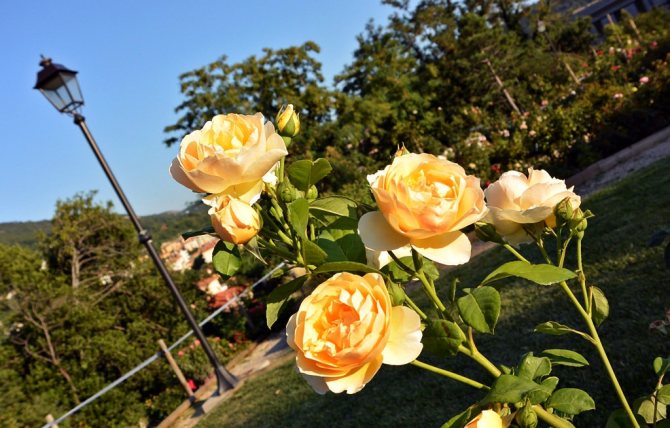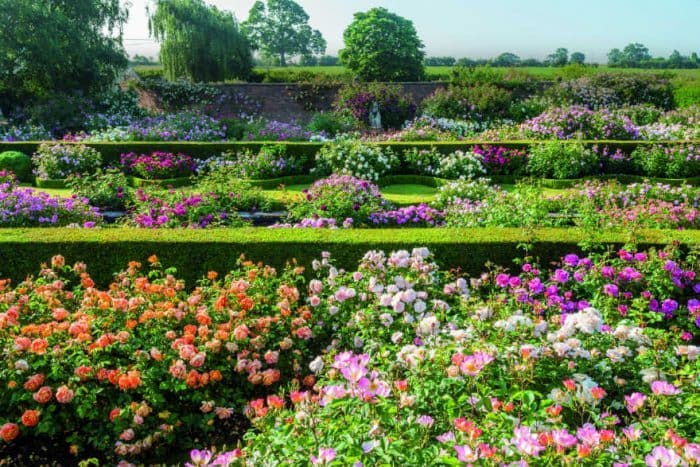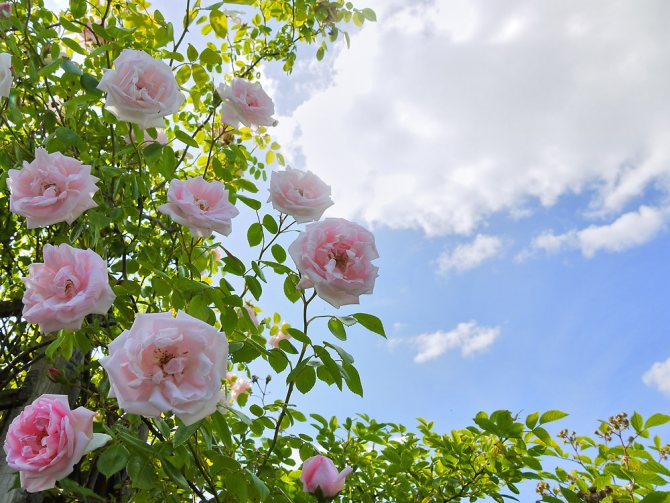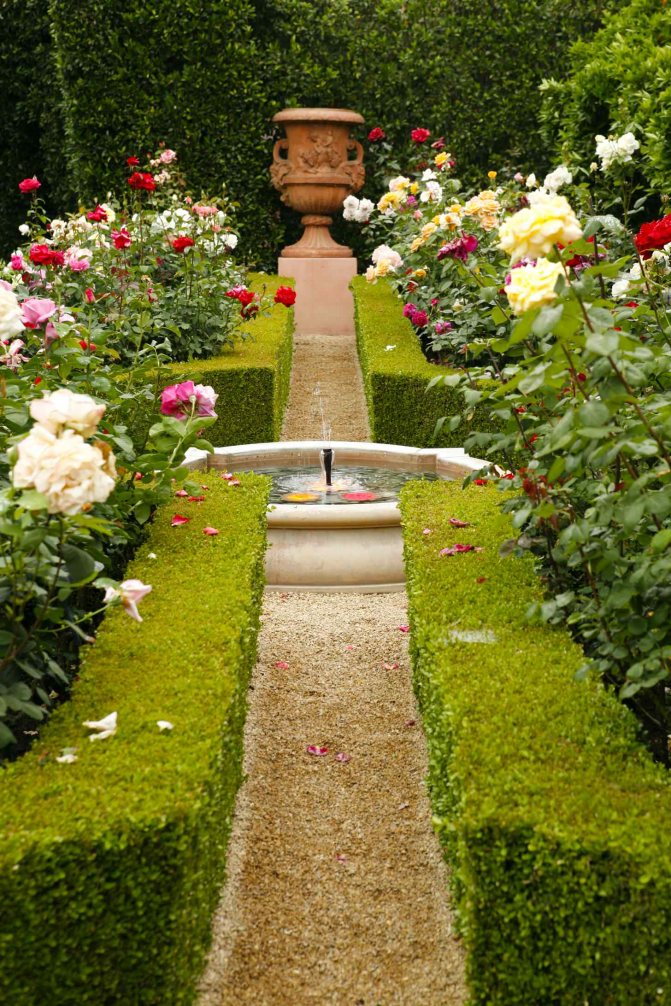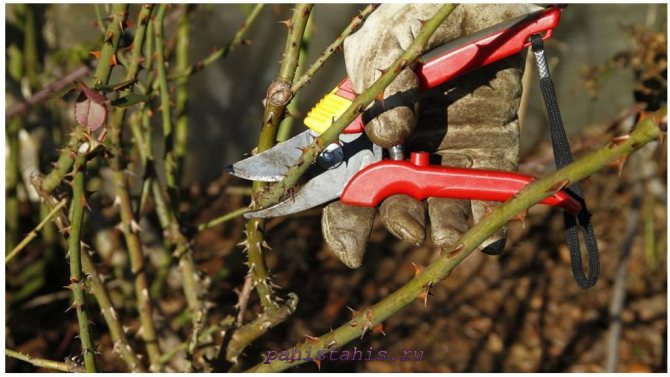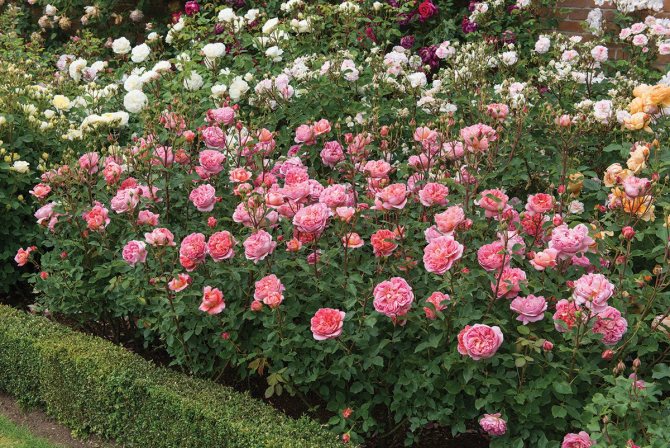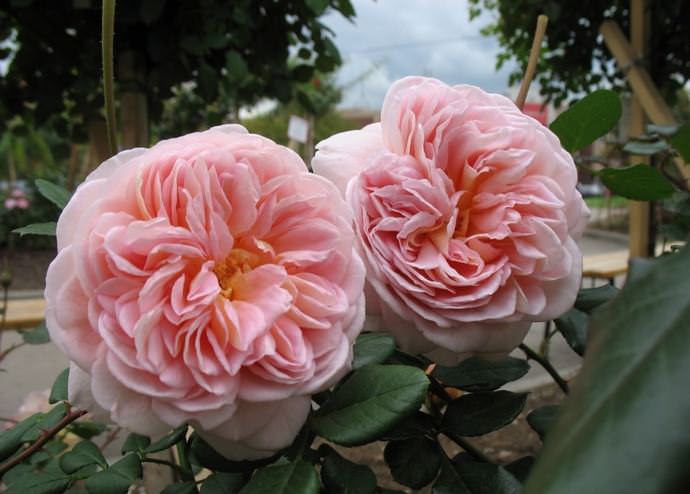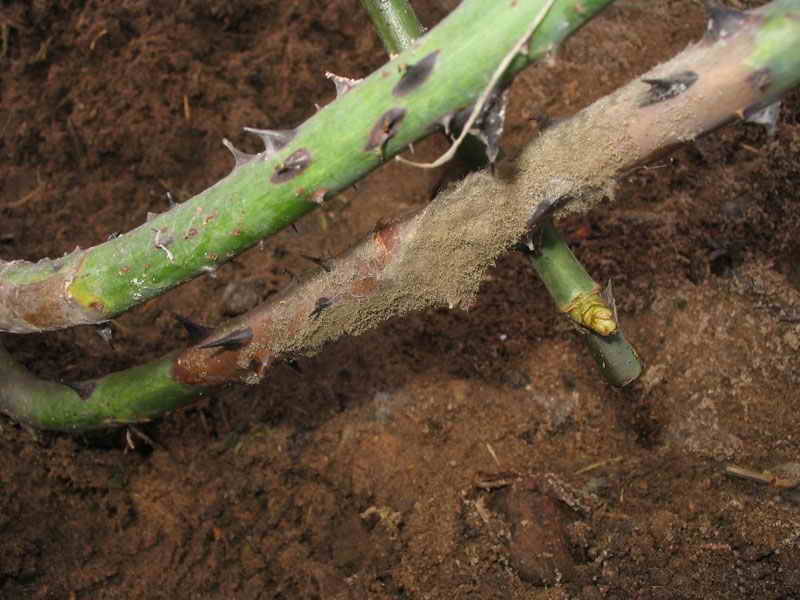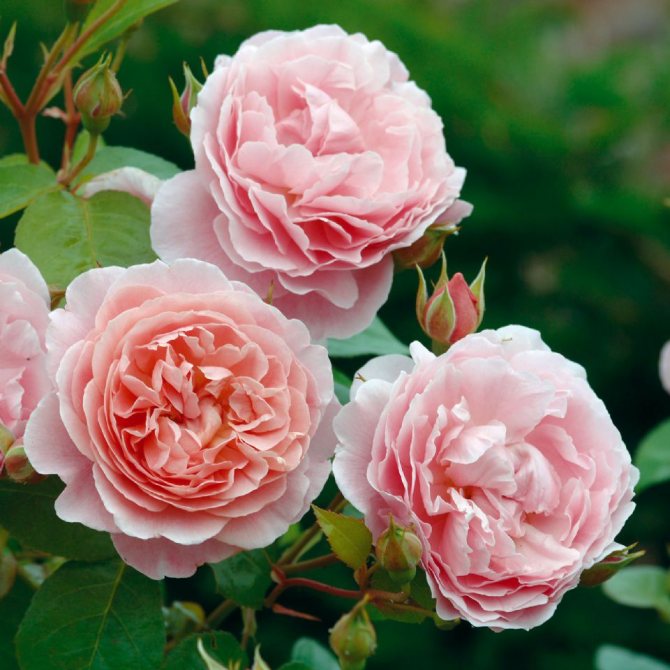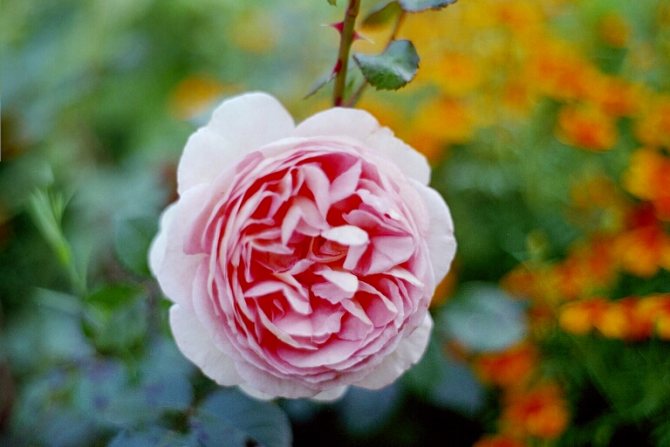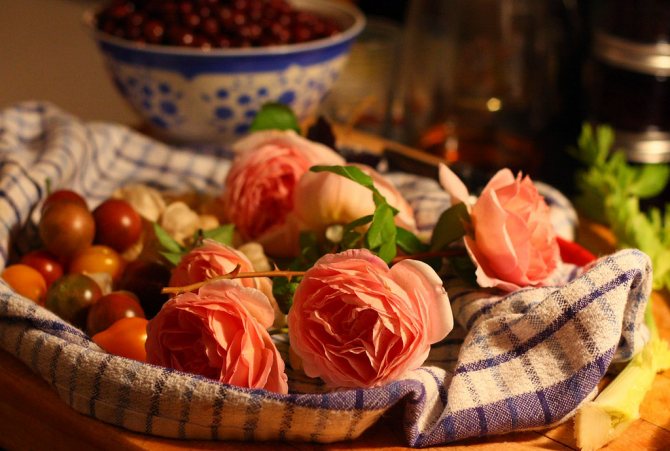English roses are increasingly found in our gardens, gradually replacing traditional varieties with a limited color palette. Bright, very lush, with an unsurpassed aroma, flowers look great in flower beds, hedges and borders, as well as in single plantings. To achieve the maximum decorative effect of English roses, you should carefully study the rules for the care and cultivation of these beautiful plants.
Pink english roses
English rose Claire Austin
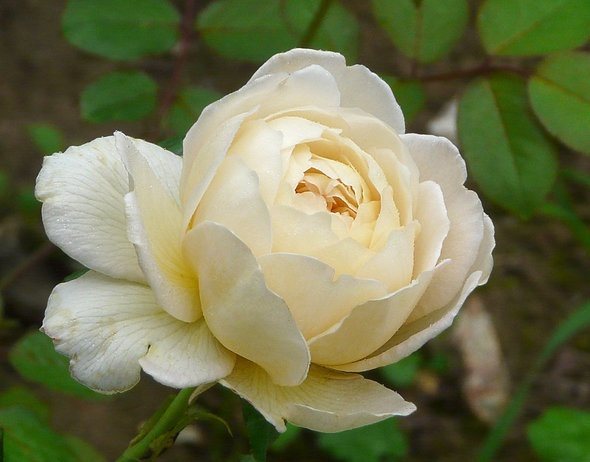
Rose Claire Austin (click to enlarge)
White English rose Claire Austin has two options - spray and curly (climber). The first variant was bred in 2007, and both varieties are named after the daughter of David Claire. Roses have no other names. The country in which the English rose was bred is England. The color of the petals is creamy white, and their number goes over 40pcs, and for the climber - 120pcs. They are collected in a beautiful, perfectly shaped bowl. Both the Claymer and the Claire Austin bush rose thrive at temperatures from -10 ° C to + 40 ° C. At lower temperatures, roses require additional shelter. The size of the shrub (bush) is 1.2m by 0.9m. Claire Austin rose clammer's lashes can be up to 2.5m long. Both varieties bloom all season and captivate with a strong, typical English rose, musky scent with hints of vanilla. Clare Austin rose variety in the form of a bush will perfectly decorate any version of a flower bed - a mixborder and is suitable for high borders. A curly variety of roses is planted near arches, columns, obelisks, walls, trellises, fences.
Types and varieties of English roses
Beautiful roses
Several dozen British roses are suitable for growing in Russia. Depending on the conceived landscape design, varieties can be planted in the adjacent garden area:
- white and white-pink (Susan William Ellis, Desdemona, Tranquility, Pilgrim);
- red and crimson (Tez of Deberwils, Falstaff);
- pink (Jubile Celebration, Braze Cadfael);
- yellow (Crown Princess Margaret, Golden Celebration).
On a note! Austin orange roses (Pet Austin, Charles Austin) look especially interesting.
For lovers of fragrant flowers, breeders recommend some of the most smelly British varieties:
- Roald Dahl.
- Desdemona.
- Anciente Mariner.
- The Poet's Wife.
- Olivia Rose.
- Claire Austin.
- Golden Celebration.
- Jubile Celebration.
- Princess Alexandra Kent.
- Wolerton Old Hall.
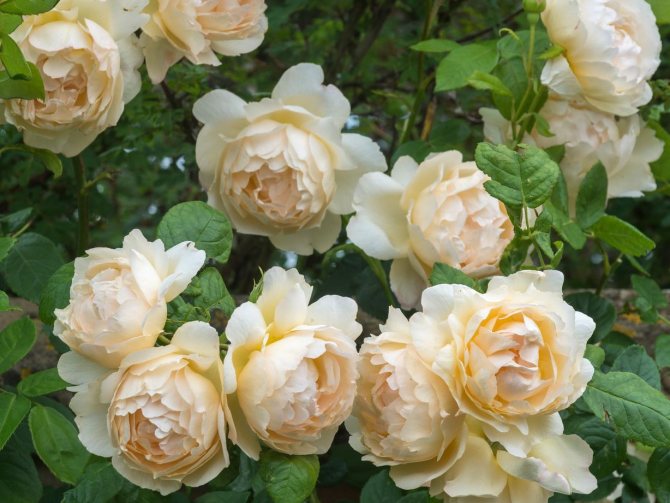

Wolerton Old Hall
Suitable for cultivation in semi-shaded gardens:
- Roald Dahl.
- Anciente Marinerf.
- Desdemona.
- Albrighton Rambler.
- Claire Austin.
- Queen of Sviden Christina.
- Crown Princess Margaret.
- Wolerton Old Hall.
- Lady of Shalotte.
- Golden Celebration.
The best climbing roses of British selection, suitable for growing in Russia:
- Albrighton Rambler.
- Claire Austin.
- Crown Princess Margaret.
- Pilgrim.
- Wolerton Old Hall.
- Falstaff.
- Theses of Deberwils.
- Theazine Georgia.
- James Galway.
- Spirit of Freedom.
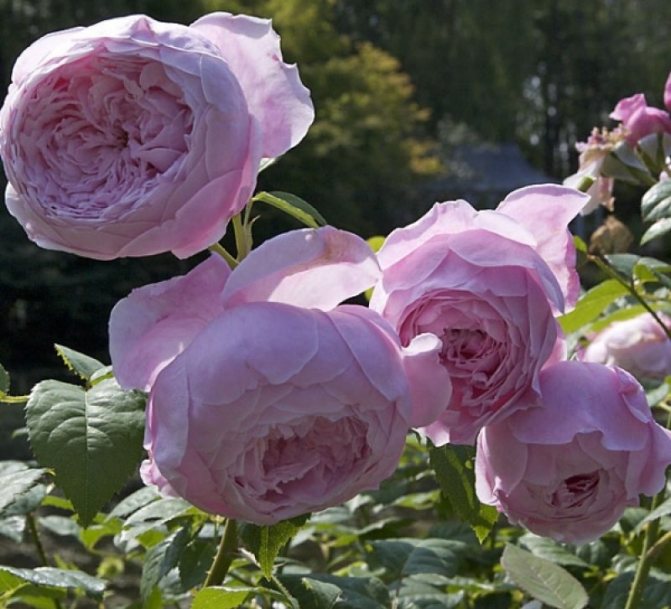

Spirit of Freedom
For small cut flower businesses, English breeders offer several dozen varieties suitable for this type of business. The most popular ones are:
- Anciente Mariner. Double pink flower with abundant continuous flowering.
- Darcy Bussell. Raspberry dense double flower with an amazing fruity aroma.
- Eglentine. Strong double pink flower with continuous flowering.
- Golden Celebration.A very large flower with a calyx diameter of 14 to 16 cm. The petals are colored in all tones of yellow. Flowering is continuous.
- Jubile Celebration. A pink rose with a golden glow from the inside of the cup. Flowering is continuous. The flowers are large, 12-14 cm in diameter. The variety has an amazing aroma with strawberry notes.
- LD Brightwhite. The flowers are maroon in color with a classic pink scent. Flowering is continuous.
- Queen of Sviden Christina. Amazingly beautiful pale pink flower. Resistant to frost.
- Theses of Deberwils. The petals are painted in carmine red shades. Smells like a classic pink scent. Resistant to powdery mildew and black spot.
- Alnwick Rose. A pink rose with double cup-shaped flowers. Blooms profusely and continuously. It smells like a fruity aroma with hints of raspberries.
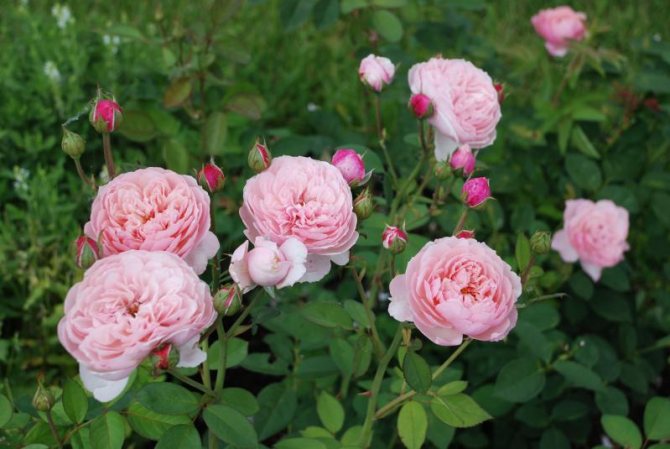

Alnwick Rose
Rose Fea Bianca (Fair Bianca)
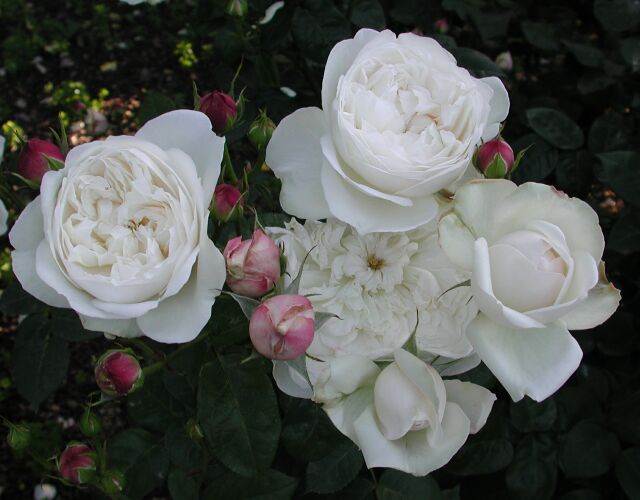

Rose Fair Bianca
Another white English rose by David Austin is called Fair Bianca. Winter-hardy variety of English roses - tolerates temperatures up to -25⁰С in dry climates. The rose does not tolerate long rains, the flowers do not bloom. The negative quality of this very beautiful and compact rose (does not grow more than 1m in height) is its tendency to disease (spots, powdery mildew and rust). The flowers of the rose are white, bloom from almost round buds, collected in inflorescences of 3-5 pcs. in one. There are few of them on the bush, and this Austin rose should be planted at least three bushes to achieve a decorative effect. Cut flowers keep their freshness for a long time, are suitable for wedding bouquets. In the garden, it can grow in partial shade on slightly acidic or neutral soils. The year of birth of David Austin's rose is 1982.
Pruning, watering and feeding
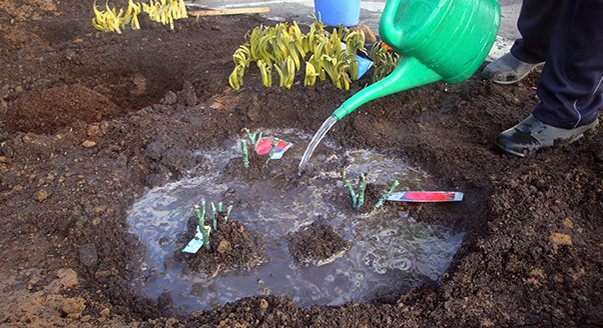

Watering roses after planting
For English roses, pruning is a must. Bushes begin to form almost from the moment of planting. After the buds wake up in the spring and the formation of the first shoots up to 5 cm long, they rake the ground from the base of the bush, loosen the soil a little and sprinkle it with sawdust, needles or straw to retain moisture. As soon as the stems get stronger, the bush is thinned out, leaving 3-4 shoots. To get the largest flowers possible, the grown shoots are shortened by half, and if you cut the stems by a third, the bush will be covered with buds. Climbing varieties are pruned only 1/5 of their length. Withered buds and faded roses must be removed from the bush in a timely manner in order to promote the formation of new flowers.
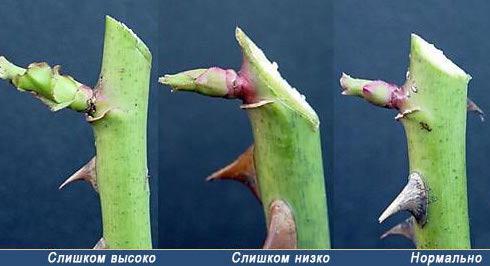

Pruning roses
It is recommended to prune mature bushes in April, before buds bloom. Pruning later will postpone the flowering time of the rose. Sick, broken, weak and small shoots should be removed without regret. Old lignified shoots are cut every 4-5 years, making room for young growth. It is very important to take into account the characteristics of each particular variety when pruning, and instructions for the formation of a bush are usually included in descriptions in catalogs.


Graham thomas


Fisherman's Friend


Claire Austin
The trimming tool must be well sharpened to get the most straight cut. It is very easy to damage the bark and infect with a blunt pruning shears, causing the shoots to dry out. Another important rule: the cuts should be done at an angle and at a distance of 5 mm from the kidney. It is advisable to immediately treat the cut points with garden varnish or a disinfectant solution.
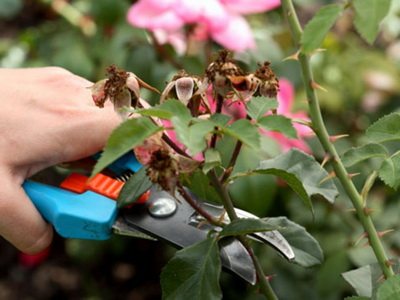

Pruning roses with pruning shears - photo
English roses are watered as the soil dries: for climbing varieties, up to 15 liters per bush are required, for ordinary ones - 5 liters. It is best to water in the evenings with settled melt or rain water, but using chlorinated tap water is highly undesirable. It is also not necessary to excessively moisturize the leaves of plants, from this diseases develop on roses.You can not water the rose often and in small doses, as this develops surface roots that are easily injured during soil cultivation. The most optimal regimen is once every 4-5 days in dry weather. When the heat comes, only warm water should be taken for irrigation, otherwise the absorbency of the roots decreases, the plant weakens, the buds do not open. They stop watering around the end of August, and in a rainy summer a month earlier.
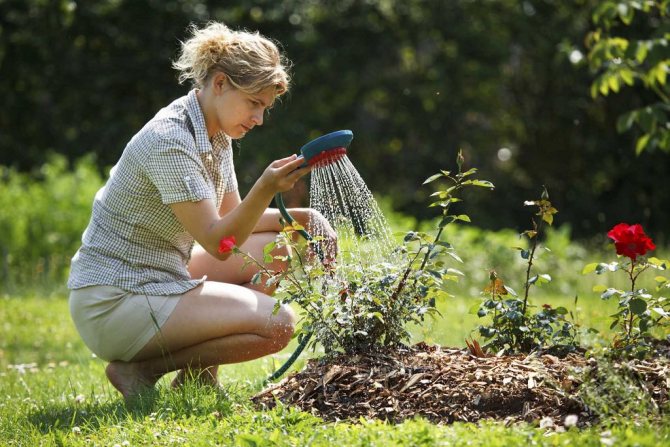

Watering and feeding roses
The bushes are fed at least three times a season: before flowering, nitrogen-containing fertilizing is applied, during flowering, organic matter and complex trace elements are required, and before wintering, plants most of all need fertilizers with phosphorus and potassium. If the planting holes were filled according to the rules, in the first year the roses need not be fed.
In the second year, a good result is given by feeding with bird droppings or mullein infusion. Litter is diluted with water in a ratio of 1:20, mullein 1:10. The infusion is used only freshly prepared. To improve the structure of the soil and better assimilation of useful elements, the soil around the bush must be mulched with a layer of peat up to 8 cm thick. This protects the roots from overheating, accelerates their development.
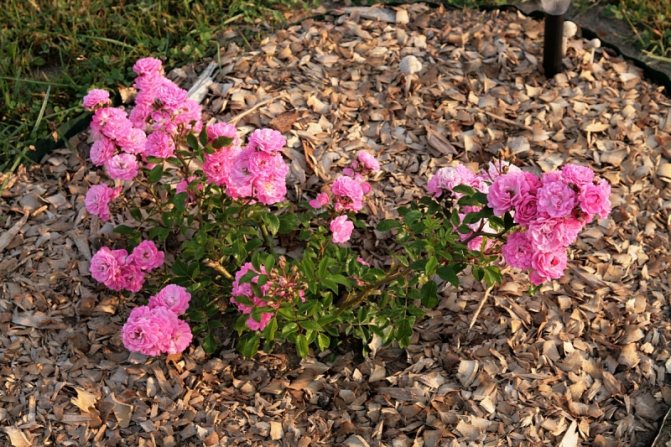

Mulch for roses
Rose Glamis Castle
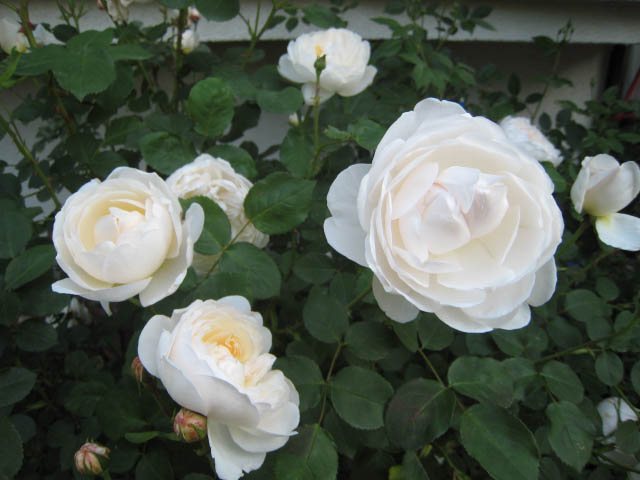

Fragrant rose Glamis Castle
The English rose Glamis Castle has a compact bush. The flowers of the rose are white with a creamy tint. They are densely double (more than 120 petals) and appear throughout the summer. At very low temperatures, requires shelter and can be affected by powdery mildew or spotting. To prevent the appearance of fungal diseases, preventive spraying is used. Like all roses, it prefers neutral soils with good drainage. Poorly tolerates heavy clay soils. In prolonged rains, flowers do not open. The branches are strewn with thorns, but tender, fragile. The size of a flower with proper care reaches 10cm. The smell is classic, myrtle.
The English white rose, Glemis Castle, is grown as a curb plant. It is also suitable for cultivation in containers, vases, pots and other containers. A single plant requires additional supports for the branches due to their fragility (especially with abundant flowering). Year of birth of the variety Glemis Castle - 1992.
Preparing for winter
English roses, in the absence of protection, do not tolerate Russian winters, therefore, for successful wintering, they require thorough preparation and protection. The preparation is proper care during the summer and regular feeding. Frost protection should be taken care of separately.
With the onset of autumn, it is important not to pluck flowers from the bushes so that they can bloom and crumble on their own. This will contribute to a more complete ripening of the shoots. With the onset of cold weather, not flown leaves are removed, and unripe shoots are cut out completely. Then you can start covering.
Important! Covering plantings is possible only after a steady drop in temperature to negative readings (but not lower than -10 degrees).
Rose Francine Austin
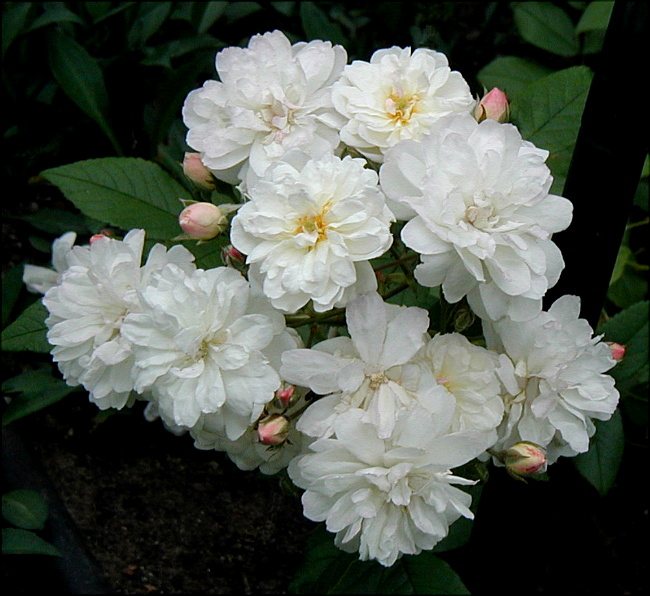

Rose Francine Austin
David Austin's English roses have a beautiful spray variety Francine Austin. It can be grown as a climbing and bushy plant. In the first version, the branches of the rose grow up to 2m in length, in the second case, the bush has dimensions of 0.9m by 1.2m. The author of the rose is David Austin. On the brushes, from 10 to 30 white flowers open. The foliage is pale green. The aroma is strong, reminiscent of the classic aroma of old roses with hints of musk. Branches are strong, spreading. Quite cold-resistant white rose. However, it requires preventive spraying against spot and powdery mildew.
The English rose Francine Austin is an excellent plant for curbs, alpine slides and rocky gardens, near walls, as well as for growing on a trunk.Rose flowers, white deep bowls, appear throughout the summer, and under satisfactory conditions, until the first frost. It is better to choose landing sites from the south, east or west. Rose prefers well-drained areas and sun.
How to plant an English rose (video)
English roses go well with many flowering annuals and perennials. So, tall bushes look great in joint plantings with delphinium and phlox, foxglove and aconite. They are combined with veronica, sage and catnip. In the foreground, low-growing varieties can be planted with geraniums and veronica, and lilac bushes can be placed in the background. For the spring compaction of pink plantings, it is customary to use peonies, tulips and hyacinths.
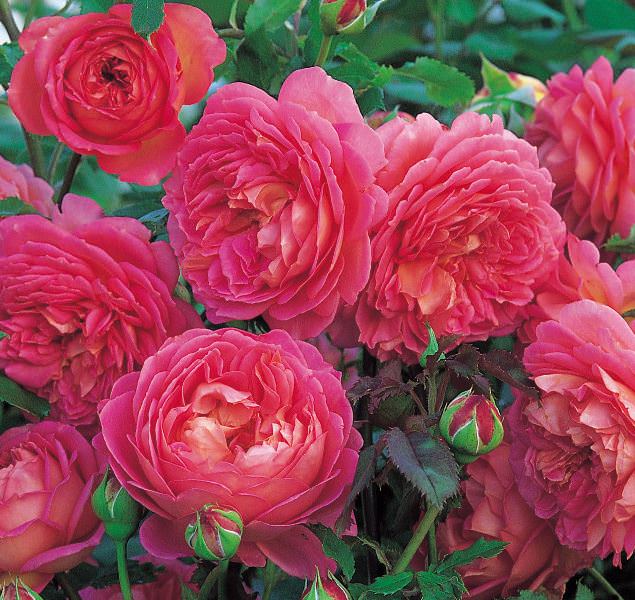

Rose Kew Gardens
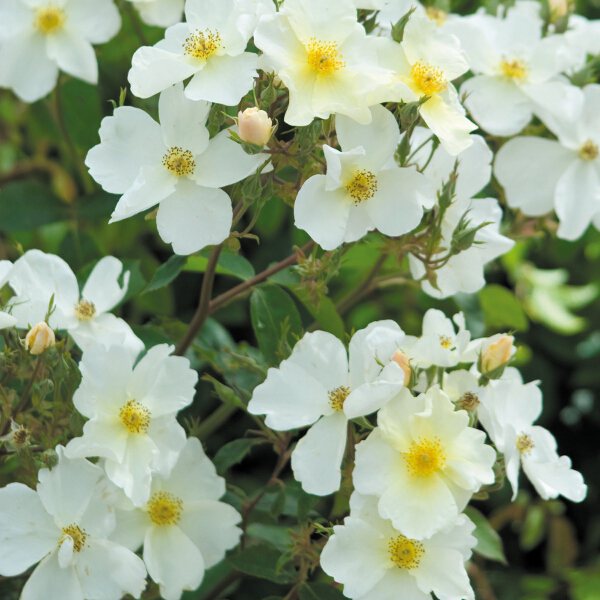

Rose Kew Gardens
Rose Kew Gardens (Kew Gardens) a variety of English roses, the flower of which is white, but with a yellow center in the form of many long stamens. The flower shape is simple, it has only 4-8, and usually 5 petals. The aroma comes out weak, musky. Kew Gardens blooms from early summer to frost. In order for the flowering to be continuous, the faded flowers are removed. Rose was born in North Africa and bred by David Austin. Registration took place in England in 2009. The soils are mostly neutral, rich in organic matter, with good drainage. The rose also behaves well on slightly acidic soils, but requires more care. Cold resistance is average, but disease resistance is quite high.
Kew Gardens is an English variety of roses grown in hedges, borders, rockeries. This ostinka rose will serve as an excellent background plant in mixborders, decorate a trellis, a retaining wall, an ugly hill (like a ground cover), will become part of a tolpiari or a standard rose.
Storage of seedlings
After the purchase, the bare roots need to be wrapped with a damp cloth, and a film should be fixed on top of it in order to retain moisture when transporting the seedling. If the roots are still a little dry, they are soaked for a day in a container of water. If it is not possible to immediately plant the plant, the root is again wrapped with a wet cloth in several layers, and then covered with polyethylene and left in a cool place. Shoots with closed roots, wrapped in foil, should be kept in a cool room (up to 10˚C) without unpacking until planting.
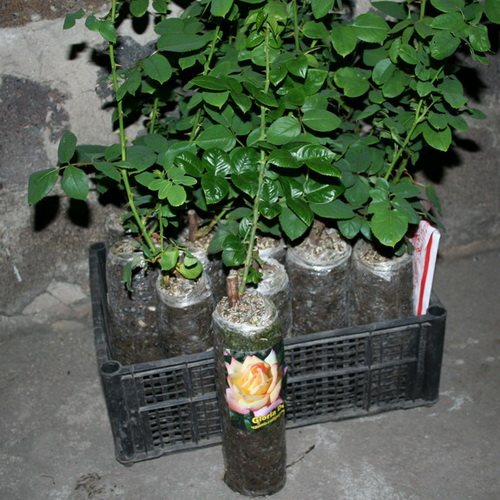

An example of storing rose seedlings
There are other storage methods:
- they dig a narrow groove up to 20 cm deep, carefully set the seedlings along one of the sides, cover the roots and lower parts of the shoots with soil. After that, the soil is well compacted and a shelter from the rain is made;
- when buying seedlings in late autumn, the roots are cut to 30 cm, the shoots are shortened, dry or damaged parts are cut out. After that, the plants are placed in boxes and covered with wet sand. An unheated basement is best suited for storage, which does not freeze even in severe frosts.
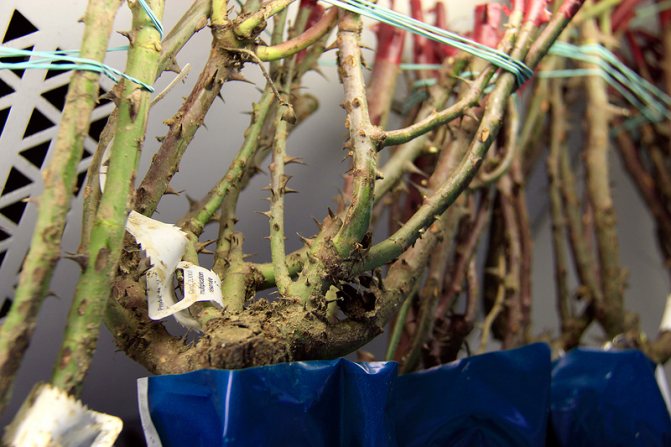

Rose seedlings - photo
Rose Lichfield Angel (Lichfield Angel)


Rose Lichfield Angel
Another white rose from David Austin's English roses - the Lichfield Angel rose smells lightly mixed with carnation and water lily. The size of the bush is from 1.2m to 0.9m. flowering repeated from June to October. The bud is pink and blossoms into a creamy white double flower - a cup-shaped rosette. If a rose grows in a sunny place with prolonged light and high temperatures, the flower fade to a pure white color. The size of flowers, collected in three pieces per stem, can reach 10 cm in diameter.
Rose Litchfield Angel requires winter shelter and preventive sprays against powdery mildew and spotting. Long-term humidity (rains) negatively affects flowering: the flowers lose their decorative effect and do not bloom. This ostinka rose is suitable for cutting. Like all roses, it prefers organic-rich soils with neutral acidity, but it also grows on slightly acidified soils.With good care, it pleases the owners with excellent flowering in all kinds of flower beds. In the rose garden, the Litchfield Angel rose serves as a transitional link from yellow roses to pink and vice versa.
English roses: features of growing (video)
Regardless of the type of bush, roses must first be earthed and then insulated. Bush varieties are surrounded with a mesh or foam panels, roofing felt or plywood shields, after which the cavity of the shelter is covered with dry materials: leaves, shavings, spruce branches or loose dry humus. Climbing roses are laid on the surface of the soil and pinned, after which they are covered with spruce branches and leaves with a layer of at least 30 cm. From above, the plants are covered with foil or roofing material. It is necessary to remove the shelter in the spring after warming to 0 degrees.
Rose Susan Williams-Ellis
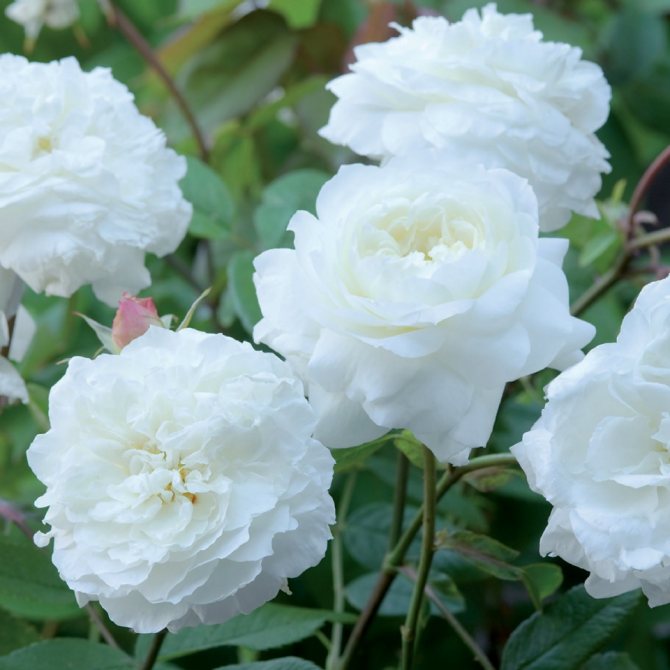

Rose Susan Williams-Ellis
Rose Susan Williams-Ellis is owned by David Austin Rosers and was bred in 2010. In areas with a warm climate, the rose begins to bloom at the end of May, in cold regions - a month later and blooms almost continuously. The flower is densely doubled and resembles the double flowers of a mock-orange. Flowers are collected in brushes of 3 pcs. one. Plant sizes start from 0.8m to 0.8m. In appearance, the Susan Williams-Ellis rose is similar to the Antique Roses, and the scent only confirms it (rose oil) and is as strong as the Antique Roses.
The main pests are aphids, caterpillars, spider mites, leafhoppers, sawflies and worms. The Susan Williams-Ellis rose has a slight propensity for mottles, powdery mildew, and rose rust. All pests and diseases will appear on it only with very poor care, and so it is resistant against them. In regions with high humidity and low temperatures, it must be covered. Ostinka-rose does not tolerate shade, heavy and acidic soils, as well as the north side.
Rose growing methods: heterogeneous flower beds, borders, containers, on retaining walls, trellises.
William Shakespeare 2000
The first presentation of the rose dates back to 1987, but the variety turned out to be very painful, so 13 years later, David Austin presented a more improved hybrid, characterized by increased resistance to all types of diseases. This variety attracts with large, densely double flowers (there can be up to 120 petals in one flower) of a velvety red, very bright hue, which gradually turns into a rich purple color. At the beginning of flowering, the flowers are deeply cupped, but then, gradually opening up, they transform into more squared and flat. A large cluster of flowers forms on each shoot, flowering can last up to two weeks. The bush is erect, vigorous, fast-growing, branching profusely, strongly leafy. Leaves - large, clear green, matte
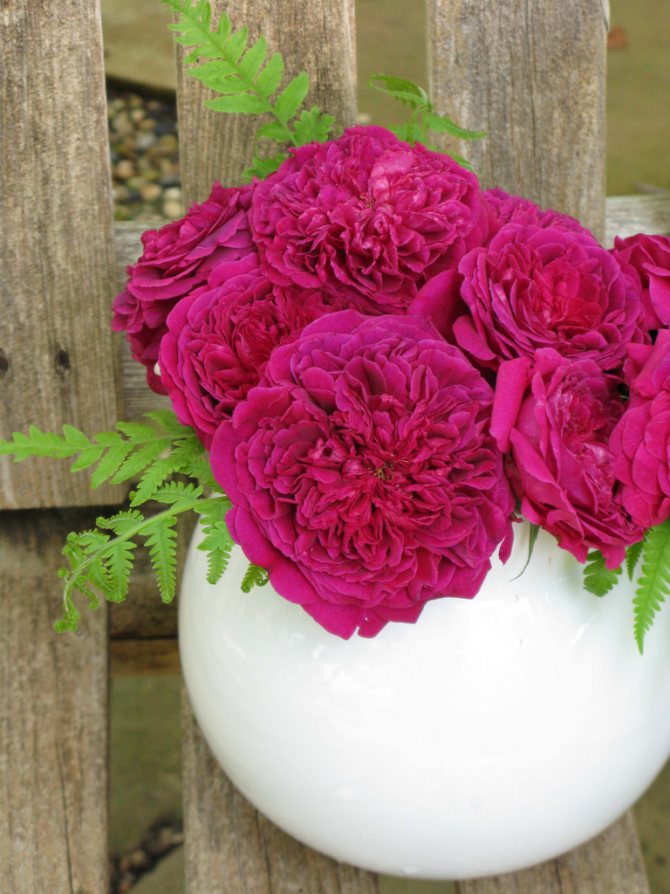

William Shakespeare 2000 is named after Shakespeare, according to a poll of the chosen millennium. The bush is erect, branched, up to 120 cm high, 90 cm wide. Flowers are dark red with a violet tinge, densely double, with a strong aroma. Flowering is continuous. According to David Austin himself, this is the best red English rose to date.
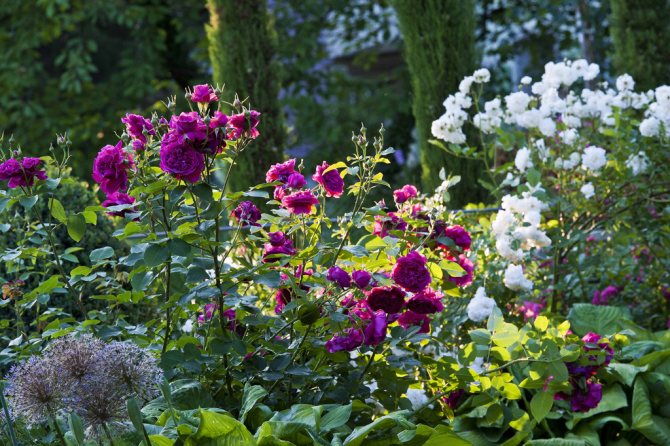

Garden arrangement of roses of varieties William Shakespeare 2000 and Prosperity against a background of cypress trees
Rose Swan
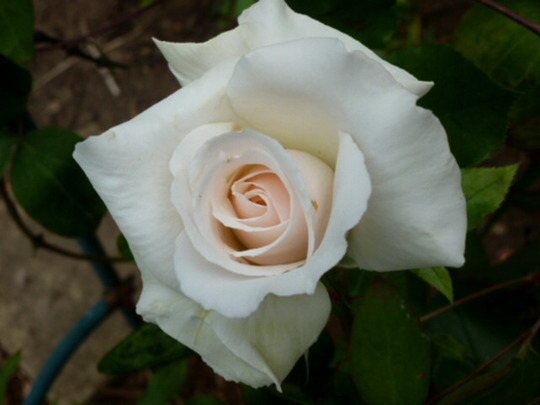

Rose Swan
The Swan variety was registered in 1987 in England. She will surprise you with the abundance of densely double flowers that appear throughout the season. The size of the flower is 10-13 cm. The aroma is light fruity, with hints of myrrh. It can be grown as a bush and as a creeping plant, as well as for cutting into bouquets. Strong, erect white rose. The height of the plant ranges from 1.2 m to 2 m, and the width is 0.9 m - 1.2 m. The leaves are dense and thorns are present. Disease resistance is good. During the period of prolonged rains, black spot and rust and powdery mildew may appear; in winter, it is imperative to use a shelter. In cold regions, you will need a short form of winter pruning for this English rose.
Rose Swan prefers neutral, well-drained and organic-rich soils, but slightly acidic (pH 6.5-6.1) will do. The rose is suitable for growing in diverse flower beds and for cutting into bouquets.
Care advice
In the classic version, caring for English roses completely coincides with the scheme of actions drawn up for other types of roses, and includes watering, feeding, pruning and combating diseases and pests.
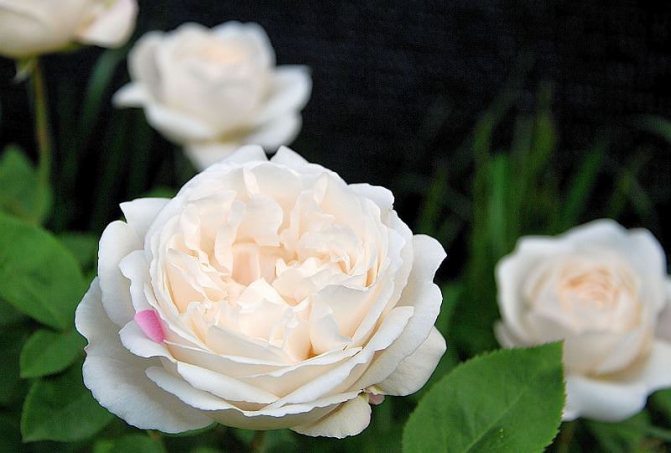

Watering
Plants have a moderate demand for soil moisture, so it is recommended to water them only when the topsoil at a depth of 2-3 cm is dry. Watering is best done in the evening. The amount of water depends on the type of bush: 15 liters are poured under curly and climbing, and 10 liters under bush.
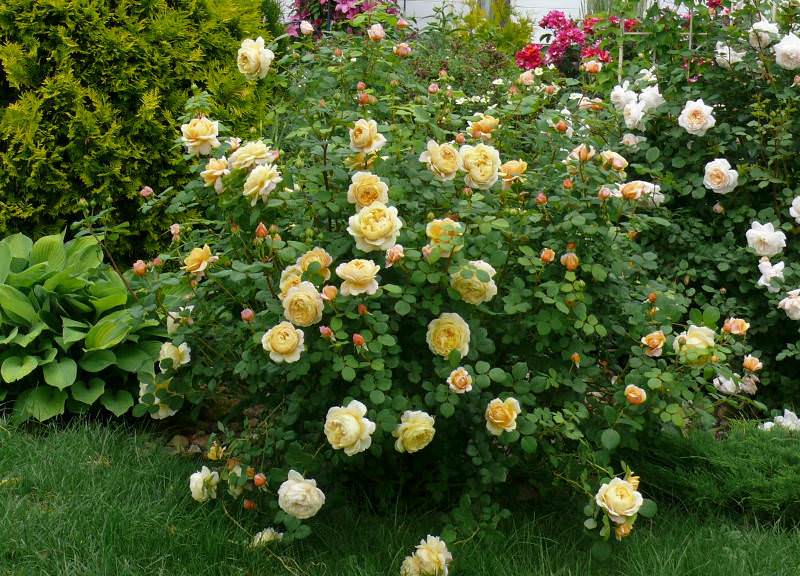

Top dressing
They begin to actively feed the flower from the second year after planting. The first feeding should contain nitrogen components, which will give an impetus to the formation of new shoots. The second feeding, consisting mainly of nitrogen and phosphorus elements, is carried out during the budding period. Closer to autumn, the rose is generously "fed" with potassium, so that it more firmly endures the winter cold.
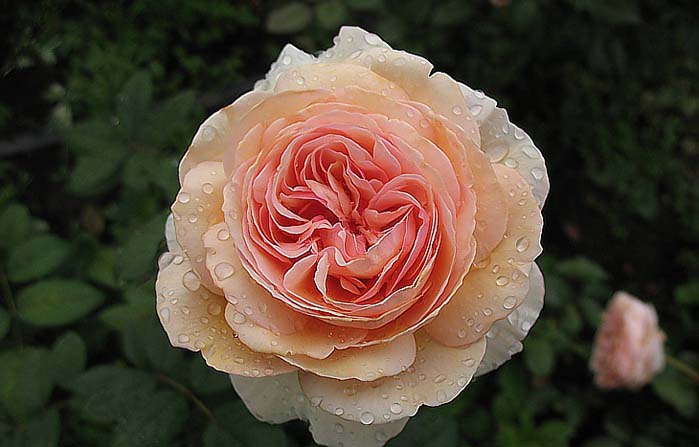

Pruning
Pruning should be done in the spring and fall. Weakened and thin twigs and shoots are subject to merciless removal, and only then proceed to the formative pruning of the bush:
- if necessary, to grow a compact bush, the stems are shortened by half;
- to obtain spreading wide bushes, shoots are cut off by a third of their length;
- for climbing varieties, the rate of shortening of shoots is 1/5 of their part.
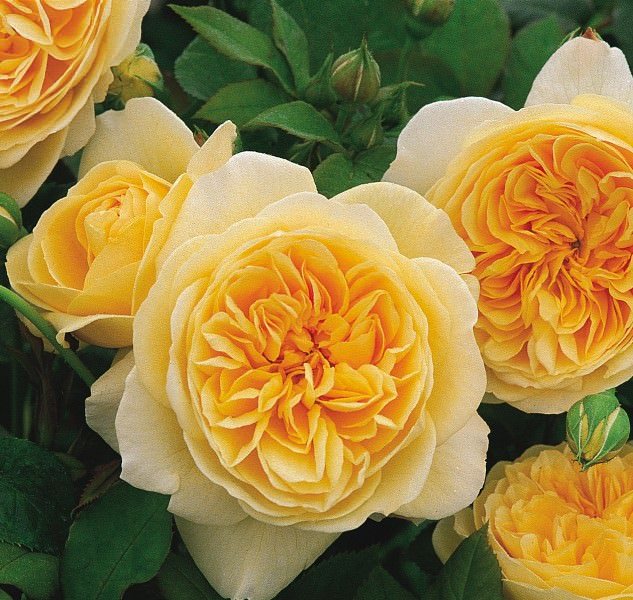

After pruning, you can feed the plants with complex fertilizers.
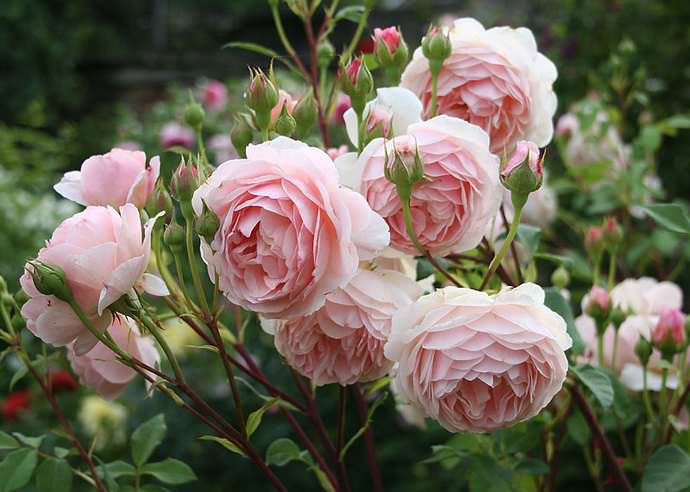

Rose Ze Nun (The Nun)
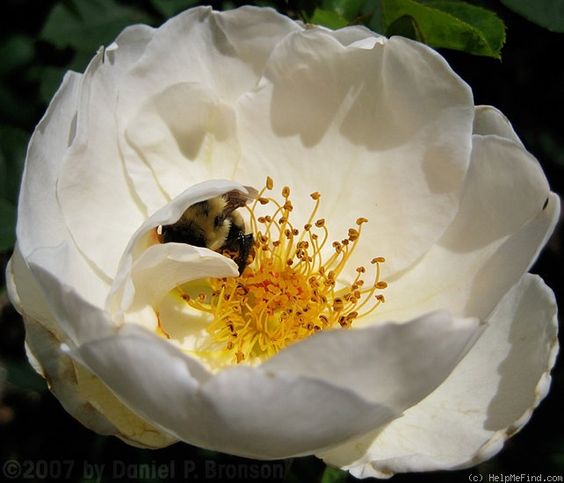

The English white rose The Nun by David Austin is almost studless. It has creamy white, semi-double flowers (9-16 petals) that reappear with proper care. The middle of the flower consists of many stamens of a golden hue.
Rose Ze Nun can be cultivated as a shrub and short claymer. This rose prefers neutral, drained soil with a sufficient presence of organic matter. It grows well and in partial shade. Northern directions for planting Ostinka are not suitable. Her resistance to diseases is above average. In cold regions, it needs shelter. Year of introduction - 1987
Austin park rose: we select varieties
A feature of almost any variety of English roses is shade tolerance, which is quite natural, given the English climate, which is characterized by a small number of sunny days.
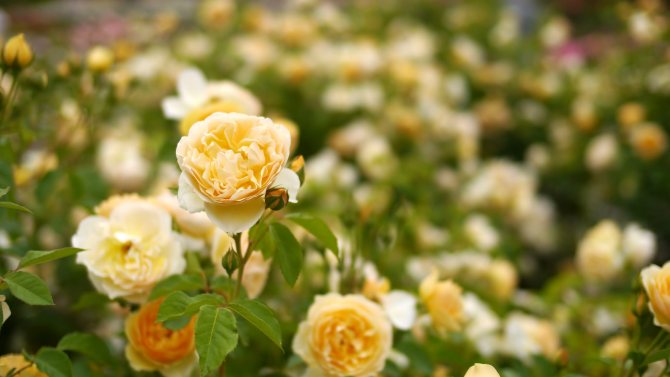

Austin roses "Graham Thomas" (pictured) are named after the famous gardener Graham Stuart Thomas. They belong to scrubs (shrubs, half-leafed roses) and climbers, i.e. braiding, but the height and width of the bush are usually not the greatest
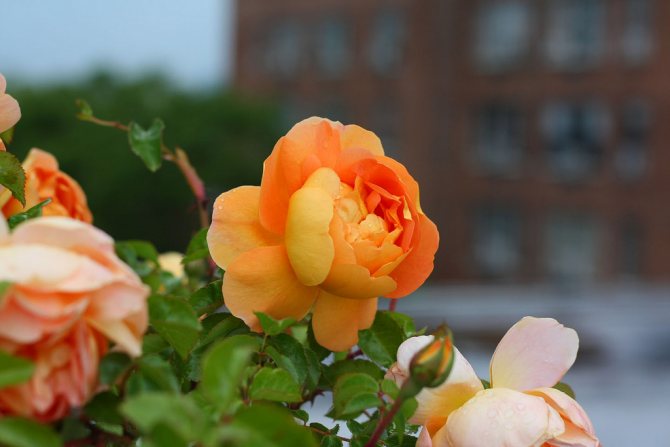

These roses are often called "modern park roses", but this is somewhat erroneous, since not all Austin roses can survive our winter without shelter, as is implied for park
For the normal development of the English rose, a place where it will be illuminated daily by sunlight for only 4-5 hours is quite suitable. But at the same time, few varieties can boast of high frost resistance, so the following are optimal for our climatic conditions.
Rose Tranquility
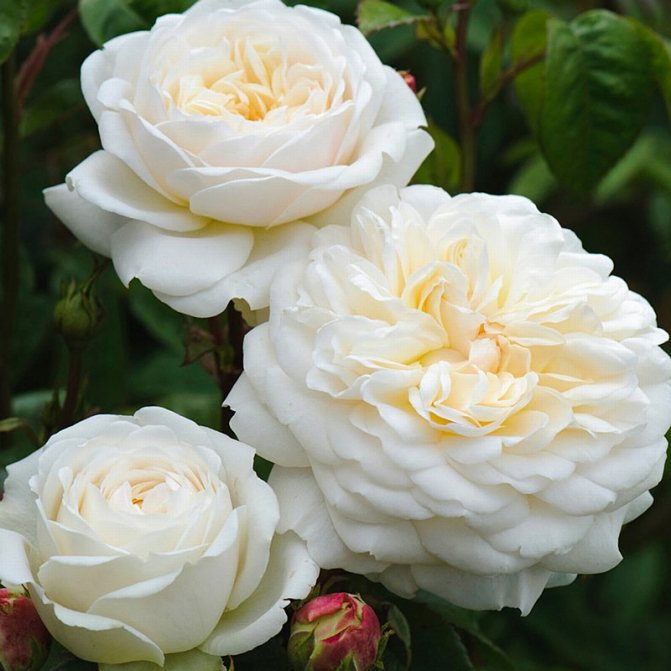

Rose Tranquility
This Austin rose variety has perfect flowers and is very popular with rose growers. The Tranquility rosebud is yellowish in color, but the fully blossoming flower is pure white. The rounded rosette flower exudes a light apple aroma and remains on the shoot for a long time. Flowers appear constantly throughout the season. In warm regions, the rose is capable of producing flowers until the first frost.
Rose Tranquility has an upright bush, densely covered with light green foliage. The size of the rose is from 1.2 m in height and from 0.9 m in width. There are very, very few thorns. It is practically not affected by diseases and tolerates frosts down to -20⁰С.
Tranquility - An English rose from David Austin can grow in all kinds of flower beds and be cultivated as a cut plant.
The use of plants in landscape design
The Austin Rose is a true all-rounder that can become the centerpiece of a garden or modestly play the role of the last, final detail in a complex with other plants. When properly pruned and cared for, they quickly form dense, tall growths that can be used as hedges.
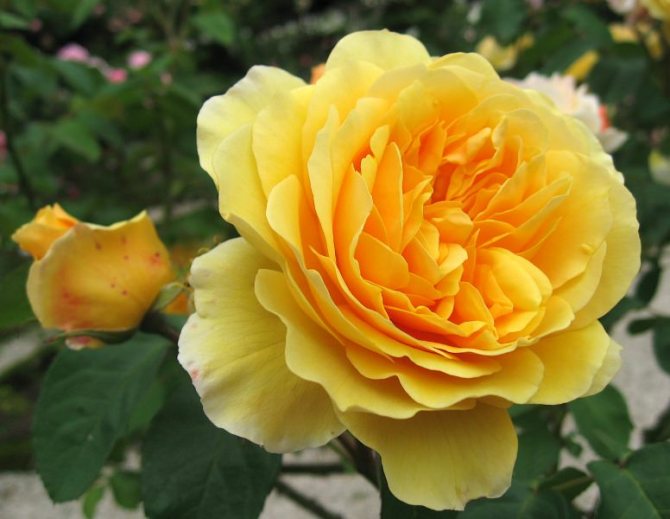

With a more careful approach to the formation of a bush and restraining their growth, plants can be used both as curbs and for decorative design of group plantings in collaboration with conifers or evergreen shrubs. Low-growing varieties can be used for container gardening or become an attractive piece of a classic flower garden.
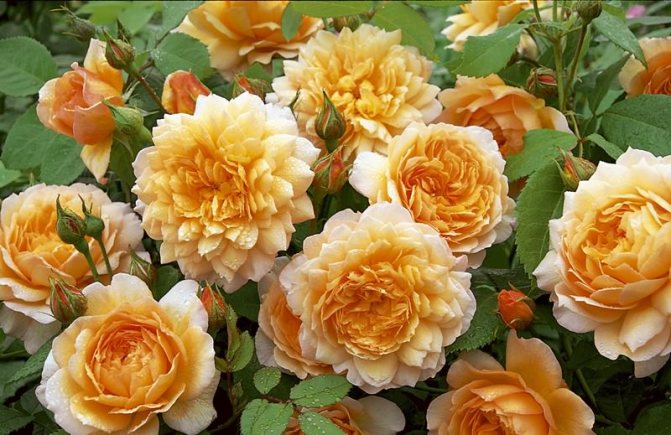

The creator of these amazing flowers even recommends using them in group plantings, mixing various varieties that may differ in aroma, and in the structure and color of the buds, and in the height and structure of the bush.
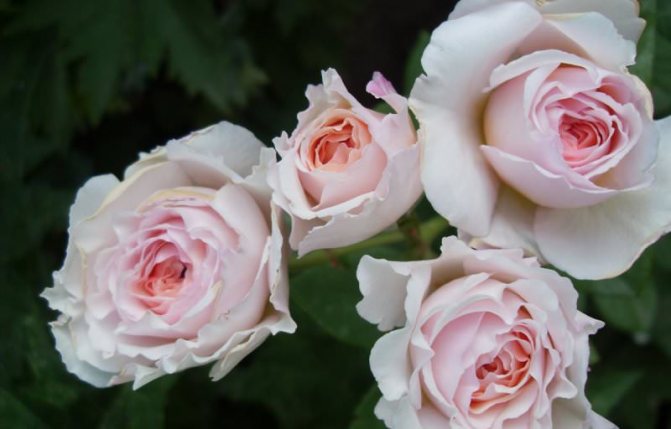

English rose William and Catherine
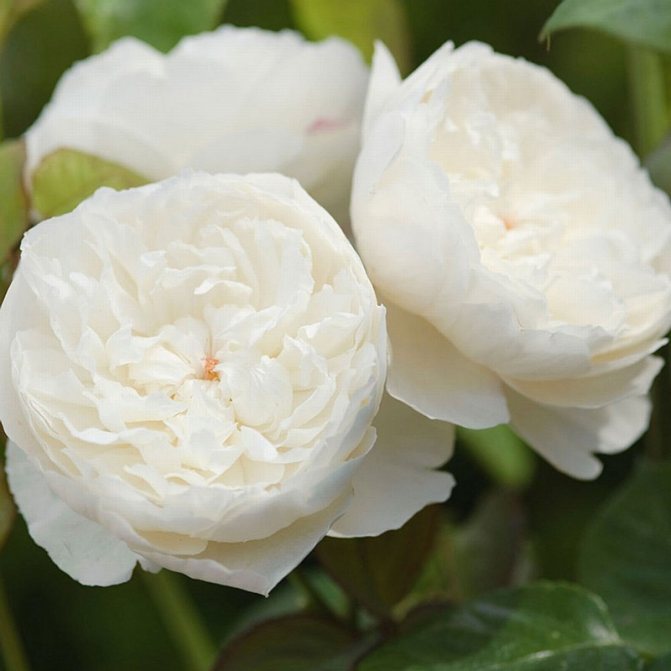

Rose William and Catherine
The English rose William and Catherine was named by David Austin in honor of the marriage of Prince William and Catherine Middleton. She is a hardy rose and a strong rose that can withstand up to -20⁰C. In regions with high humidity and low summer temperatures, preventive spraying against powdery mildew and spotting will be required.
The flower consists of a center formed of many small petals, and a "crown" around it, consisting of large petals. At the beginning of blooming, it is colored in a soft apricot shade, which quickly turns white. Flowers appear all season. The background for flowers, collected in small inflorescences, is dark green foliage. The aroma is strong, myrtle.
Like all Austin rose varieties, the rose prefers sunny places, but it also thrives in light partial shade. The English rose William and Catherine grows quickly and forms an erect shrub 1.2 m high and 0.9 m wide. And like all roses, the rose is best suited for neutral, organic-rich and well-drained soil.
Shelter bushes for the winter
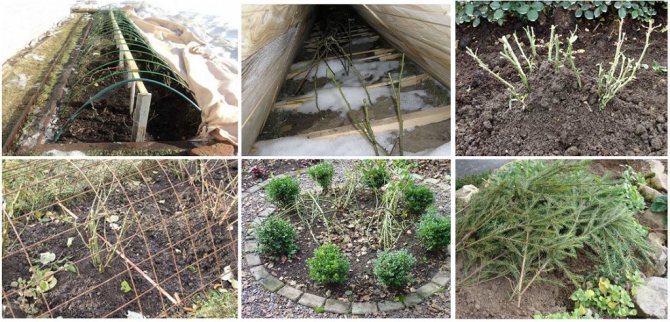

It is best to make shelters from spruce branches
When growing English roses, special attention must be paid to their wintering. In early October, the bushes are covered with dry earth or sand. It is undesirable to take peat and straw, since they cake, retain moisture for a long time, and the roots of the plants vytuyut. The stems are lightly tied so as not to break, and slightly bent to the ground. When the first frosts come, all leaves are removed from the roses and the buds are pinched, and then frames from scrap materials are installed over the bushes. These can be reinforcing bars, wooden bars, thin pipes. A dense film or a special agrotechnical fabric is fixed on top of the frame.
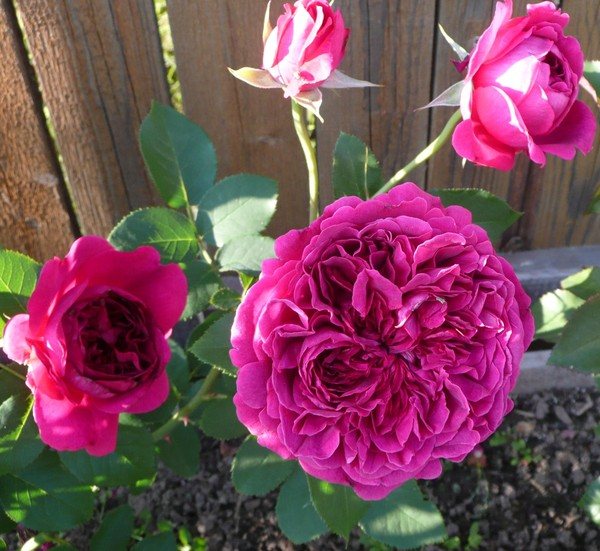

Rose William Shakespeare
Rose Winchester Cathedral
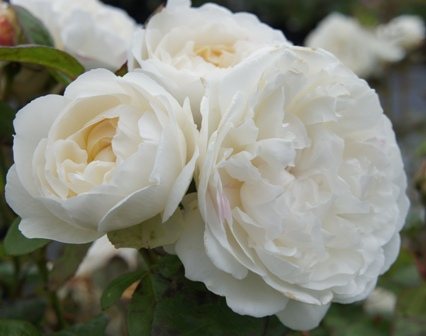

Rose Winchester Cathedral
Austin's Winchester Cathedral rose variety has full-bloom blooming all summer long, disease-resistant and cold-resistant. It can bloom very early if weather conditions permit. The bush, measuring 1.2 m (height) and 0.9 m (width), is simply covered with a mass of white flowers during full flowering. The best conditions for the successful cultivation of this rose will be chernozems with good drainage and a sunny place on the site.
The rose emanates the aroma of Antique Roses with hints of honey and almond. Plants such as erigeron, clematis, aconitum and lavender can be supplemented. It can be grown not only with other plants, but also as an independent one because of the beautiful shape of the stems. Suitable for cutting into bouquets.
Landing features
Planting flowers differs little from the procedure that is done at the initial stage of growing other varieties of these plants.Before planting, seedlings are soaked in water, into which, if possible, growth and root formation stimulants can be added. At this time, they are engaged in choosing a place for roses and preparing planting holes.
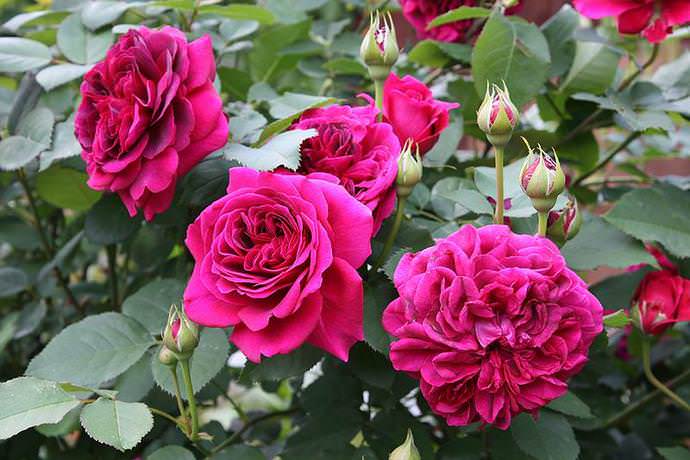

In this case, it is imperative to comply with the following requirements:
- the culture does not tolerate intense sunlight, so it is important for it to choose a place where the sun's rays fall no more than 5 hours a day;
- the site should not be flooded with melt water in spring and remain without snow cover in winter, therefore, an ideal place would be a neighborhood with gazebos and pergolas, verandas and other buildings, including fences.
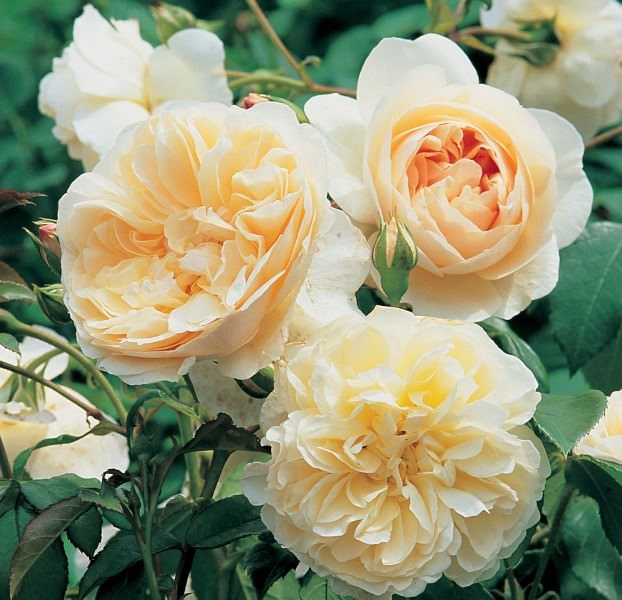

After the final comparison of the requirements and the choice of a suitable place, you can proceed to the preparation of the planting holes. For each seedling, a hole is dug 50 x 50 cm in size and the same depth. It contains fertile garden soil, mixed in equal proportions with humus. 1 bucket of water is poured into each pit and left for at least 20 hours.
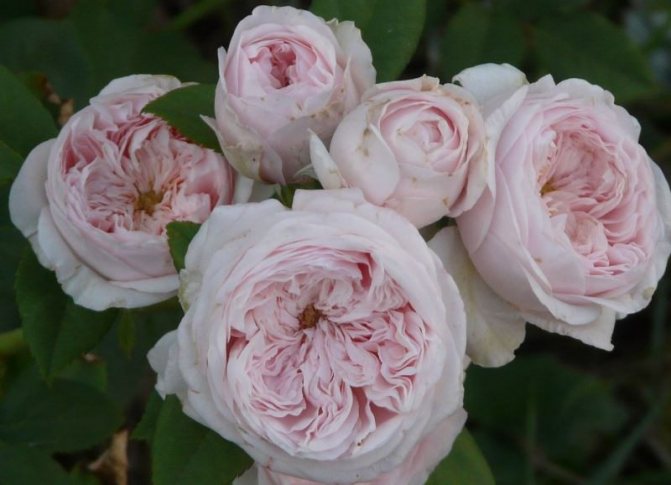

During planting, it is important to ensure that the grafting site is at least 7 cm deep and that the roots are evenly distributed. Watering the seedling in the first day after planting should be abundant - 5 liters under the bush. After that, it is advisable to slightly huddle them. This procedure will contribute to the formation of a stronger root system.
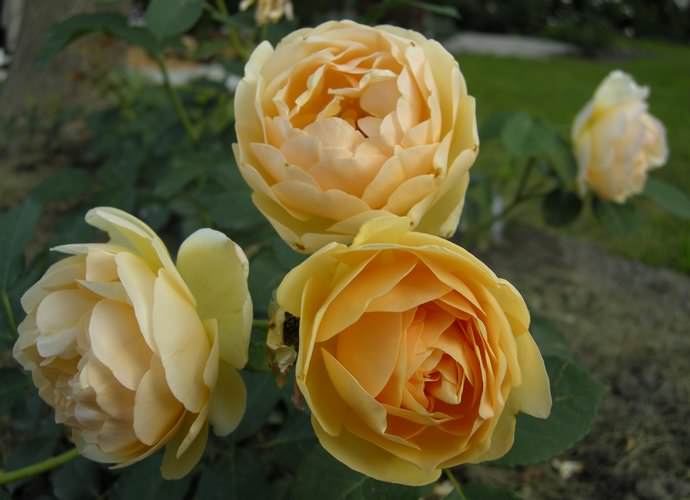

Other types of pruning: tips for beginners
The gardener can choose the type of pruning not only based on the variety of the rose, but also on the condition of the bush.
Sanitary pruning
Allows to remove damaged or frozen shoots. Applies to absolutely all types of plants. Dried, deformed, broken branches, shoots that did not have time to ripen before the onset of autumn and all the growths that drown the bush are cut out. If you do not carry out such an event at least once a year, the plant may die.
Such pruning can be carried out not only as preparation for the winter period, but also throughout the entire calendar year.
Rejuvenating
If your plant has been living for more than a year, then, like other shrubs, the shoots may become outdated, not bloom, and rot. In order to prevent this, as well as to increase life expectancy, anti-aging treatment is necessary.
- All old branches that did not grow well are cut off.
- If there are shoots with peeling bark, they should also be trimmed to the base.
- Do not leave branches on the plant that are more than 3 years old.
It is best to carry out anti-aging pruning, alternating with sanitary pruning.
For flowering
If in the last season the bush gave little or no flowering, you can take the necessary measures in the winter in order to prepare the rose for the next season. This will allow for balanced growth and good color.
- Remove shoots that are more than 3 years old.
- Be sure to examine the buds that remain on the shoots.
Look at the degree of bud development as well as the ability to bloom. The higher buds give an earlier color due to the fact that they receive more sunlight. However, these flowers are not large at all, they have short peduncles.
If you trim the upper buds, you will encourage the lower flowers to grow. They will be large and strong, with long peduncles.
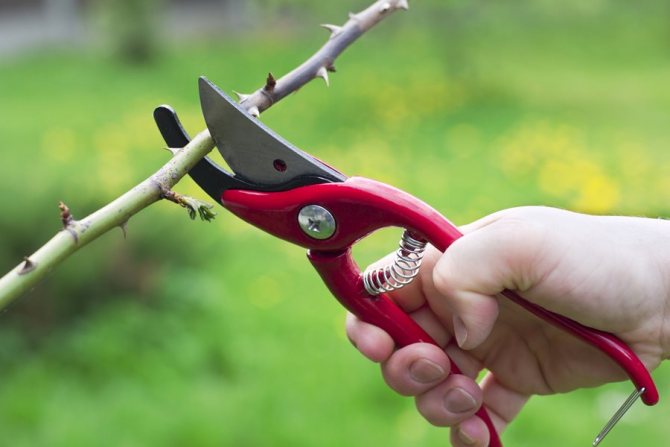

It is necessary to cut off the upper buds 2-3 future flowers down
Step-by-step instructions for pruning different types
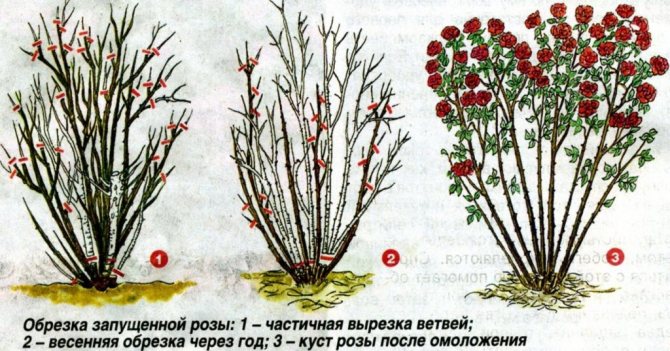

A well-groomed bush will "thank" the hostess with an abundance of flowers
Pruning usually starts in late October and ends by mid-November. The temperature at this time reaches from -1 to -5 ° C. You cannot cut off the branches when the frost has not yet begun. This will contribute to the rapid growth of the buds, which will subsequently be killed by the winter frosts.
The cut sites must be treated with special preparations against the formation of fungus. If we are talking about a large cluster of rose bushes, then the procedure can take a lot of time, be prepared for this.
Hybrid tea roses. Floribunda
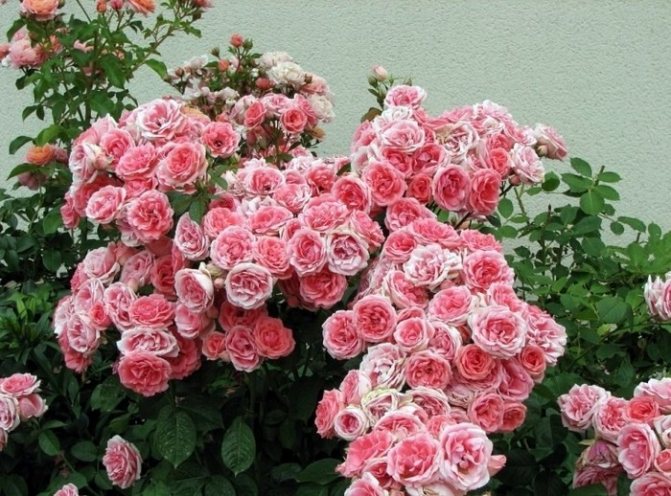

With the correct procedure, the rose does not even need to be covered
It is a very delicate plant. You can cut branches exactly to the middle of the shoots, 0.5–1 cm higher than the outer bud is located.
Such pruning will minimize the freezing of the shoots in the winter. It will benefit the plants, and the next year they will give birth to an exuberant color.
Miniature and park varieties
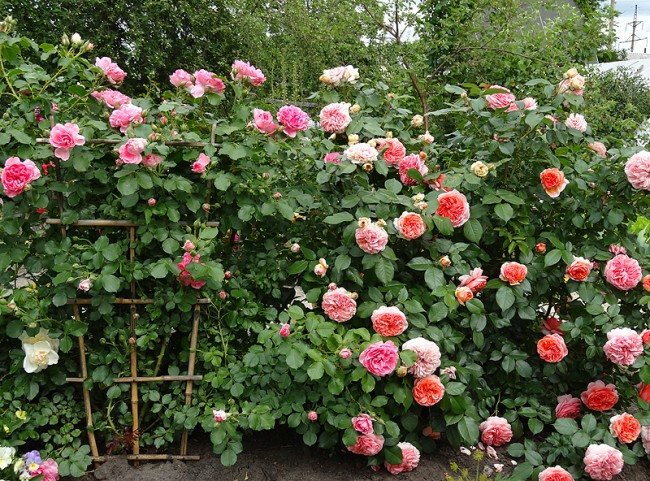

On such roses, only diseased branches are removed.
These types of flowers do not need to be pruned as such. The procedure is preventive in nature. If you want to protect the flowers from the winter cold, then you need to remove all shoots that have a weak or dried out appearance. Be sure to rip off all the leaves if they are still holding onto the stems. Healthy and woody shoots should not be touched. Small branches that are deformed or diseased can be cut out.
Pruning English and Canadian roses
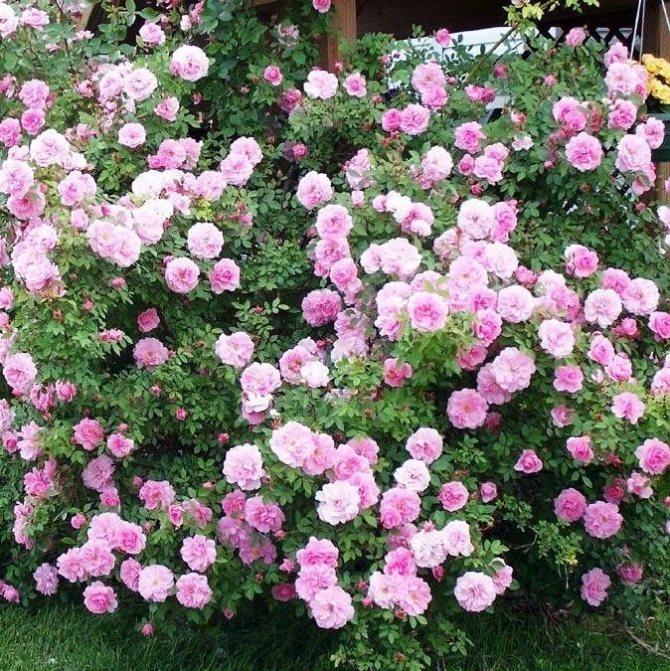

Pruning is optional but can benefit the plant
These flowers do not need pruning. But caring owners, wanting to prepare climbing plants for winter, carry out a similar procedure:
- Remove all shoots that have not faded.
- Leaves and branches are removed.
- You can remove not all shoots, but only those that drown out the bushes.
- Branches that are more than two or three years old are removed.
For example, if an adult bush consists of 6-8 branches and shoots, then exactly half is removed.
Remember that spring and winter pruning are completely different procedures that have different goals, and therefore, a different algorithm for carrying out.
Bush rose
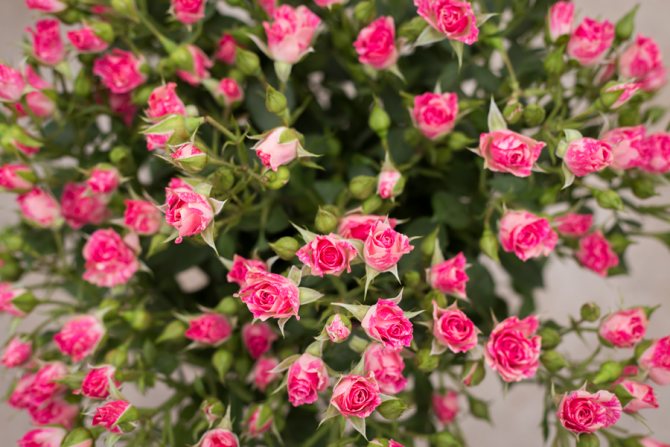

Such a flower in the fall requires special attention.
To prune this plant, several approaches are used at once.
- Low pruning of shoots. A few centimeters are removed from the ground, shoots are cut from the second to third buds from the base.
- Medium pruning assumes a cut from the fifth to the sixth bud.
- High pruning allows you to leave the entire length of the trunk, while removing all shoots.
- Combined pruning combines several types of cuts. This is done in order to give the bush to grow by the next season.
All of these types are used for various purposes.
- Low pruning is used in case the plant is very weak, it is possible that it will not survive the winter.
- Medium and high pruning is aimed at preserving the plant for the period of cold weather.
How to water
It is necessary to water the roses according to the area of occurrence of the root system. Don't pour all of the water at once. Dosed watering will ensure full penetration and saturate the soil with moisture. Do not water the foliage and flowers of the plant. Such watering contributes to the appearance of diseases: moisture at night on the bush when changing day and night temperatures will provide, for example, the appearance of powdery mildew. Do not pour water from the hose under pressure in one continuous stream - it erodes the soil and exposes the roots. Use a special sprinkler. This will allow the water to gently saturate the soil.
Pay more attention to freshly planted roses, climbing roses against walls, roses growing in sandy soils and roses growing in pots and other vessels. They need more moisture due to the special growth conditions.


As they say, all roses love fertilizers, especially English ones (according to information from the company's website). If you want to get the most healthy and beautiful roses, you need to feed them regularly.
The company recommends fertilizing roses twice a year: at the beginning of the growing season and after the first flowering to stimulate the emergence of new flowers.
Naturally, the breeder, while working on the breeding of roses, developed his own special formula for fertilizers. If you have such an opportunity, then use ready-made fertilizers David Austin Rose Food. 1.7 kg of finished granular fertilizer from D, Austin includes nitrogen, phosphorus, potassium, basic trace elements. Similar mixtures are also available on our market and you can safely use them according to the instructions.
Plant care
Perennial rudbeckia - how it blooms, popular varieties
Taking care of your rose bush doesn't take long.
Watering is best done in the evening, but the water should not be cold. After rain, it is advisable to shake off the water from the buds to avoid rotting. And the soil needs to be loosened periodically.
Only roses older than 1 year need feeding, such bushes must be fertilized from the beginning of flowering to mid-August, with an interval of 3-4 weeks.
- the first top dressing should be from nitrogenous fertilizers;
- the second - from organic and complex;
- the third - from potash and phosphorus.
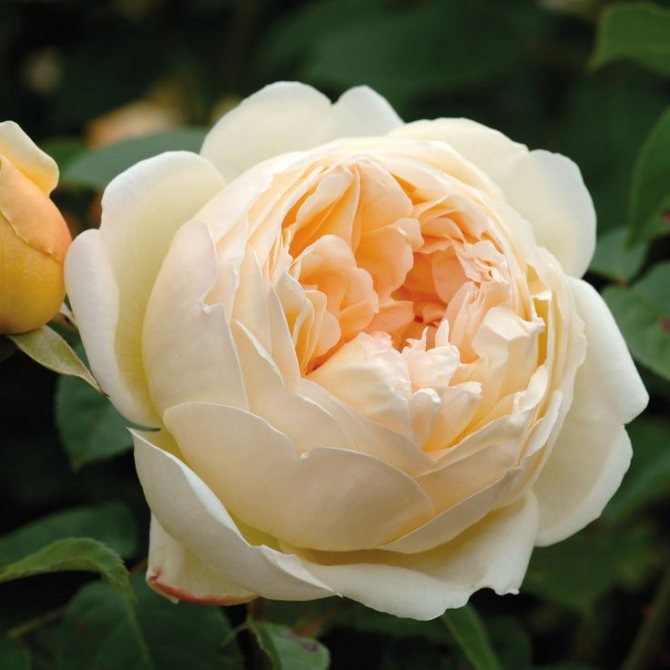

Jude the Obscure
Pruning correctly will allow the rose garden to bloom more than once over the summer; it needs to be done three times a season.
- The first - in the spring, before the appearance of young leaves - remove weak and diseased shoots.
- The second - all summer, the shoots must be pinched so that the bush becomes more magnificent.
- And the third is preparation for winter. Dry and diseased branches, dry leaves and buds are removed.
If roses need to be transplanted, it is recommended to do so after pruning, but transplanting mature roses can be problematic, as some varieties go more than a meter underground.
Important! You can cover roses for the winter with earth or sawdust, after placing poison for rodents so that they do not gnaw the roots.
How to choose the right seedling
When planting any plants, it is important to consider the climate for which they are intended and where they are supposed to be grown. Austin's species is bred in the foggy and damp lands of England. Therefore, it is these conditions that will be preferable for them. Of about 200 varieties of roses in England, at least a third of them will be able to get along in the climatic conditions of our country.


How to choose the right variety for the climate of the territorial location of the site? Canada can be taken as a sample. Their climatic conditions are almost the same as in Russia. Consequently, the varieties that they grow can be successfully maintained by us.
When choosing a seller, special attention should be paid to his competence in matters relating to English varieties. The fact is that scammers know how the seeds of this type are valued, they buy similar ones for a low price, and sell them much more expensive. Naturally, preference should be given to nurseries where this beautiful flower is professionally bred. The price is slightly higher, but this is because the sellers there provide a guarantee of climatic suitability. It is not worth buying seedlings at retail outlets located near roads. With almost 100% probability, they are affected by diseases, or they may not be at all the variety for which the buyer paid.
Growing ostins in Russia
However, there are many reviews of Russian gardeners from different parts of our country, including the Urals, Siberia, the Arkhangelsk region, in which gardeners share their successful experience of growing "Ostinok" in harsh conditions.
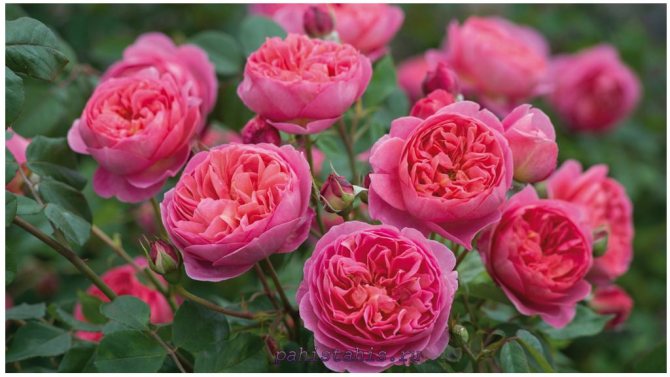

Growing ostins in Russia
On a note!!!
In Russia, according to the observations of flower growers who grow Austin roses, flowers do not behave as indicated in the catalog. Namely: they have greater frost resistance than indicated in the catalog. They grow larger or smaller (which is unpleasant, because when planting it is important to know the future size of the plant). Therefore, before buying one or another sort of "Ostinka", you should look for reviews about them on Russian forums. Study the Russian experience of rose growers. In the early years of growing such roses, flowering is poor, because the bush should grow and get stronger. But over time, this problem is solved.
The main point of growing "Ostinks" in Russia is to provide a reliable shelter. No one in the world covers roses as much as Russian gardeners. At best, they are bent down. And according to the reviews of all the same gardeners from the harsh regions, the varieties that were brought from abroad and which are not in our catalogs sometimes show themselves even better than those that are recommended for cultivation.
In 1983, at an exhibition in Chelsea (a suburb of London), David Austin presented his best varieties. Among them are Graham Thomas and Mary Rose.We can say that thanks to these varieties, the breeder and his beautiful roses have become famous all over the world.
Diseases and pests of English flowers
English roses are immune to disease. However, with improper care, the following problems appear:
- powdery mildew;
- rust on the leaves;
- mosaic;
- gray rot.
The affected shoots are removed, the bush is treated with Bordeaux liquid or copper sulfate.
Among the pests, aphids are most often found; to eliminate the insect, the bush is sprayed with laundry soap dissolved in water.
Pruning period for roses
Spring is the right time to prune roses. The forsythia bloom can tell you when to grab the pruner. As soon as the forsythia is covered with golden flowers, and the buds begin to swell at the bottom of the rose bushes, then you can start pruning. Somewhere at the end of April.
If you cut the roses earlier, then the cut shoots will freeze during frost. Then the lush bloom of the rose will come later. If you delay pruning, the rose will waste its energy on the growth of new foliage and shoots. As a result, the plant will be weak, and the flowering is not lush.
Wild shoots, which often appear below the graft, are cut off. To do this, you need to expose the root collar and cut it off at the base.
When pruning roses in summer, you need to remove faded flowers, thus ensuring re-flowering. In the fall, it is necessary to cut off overgrown rose bushes, remove branches affected by fungi.
But the main pruning of roses is carried out, as noted earlier, in the spring, when you can see which branches have not overwintered, and which ones show swollen buds.
The Mayflower cultivar
Mr. Austin has been working hard to develop roses with increased flowering. As a result, in the 70s, many new varieties appeared, which, unfortunately, turned out to be susceptible to diseases. We turned out to be quite capricious in leaving. The breeder did not stop working in this direction and brought out a number of varieties that are more resistant to diseases. The first such variety is called The Mayflower.
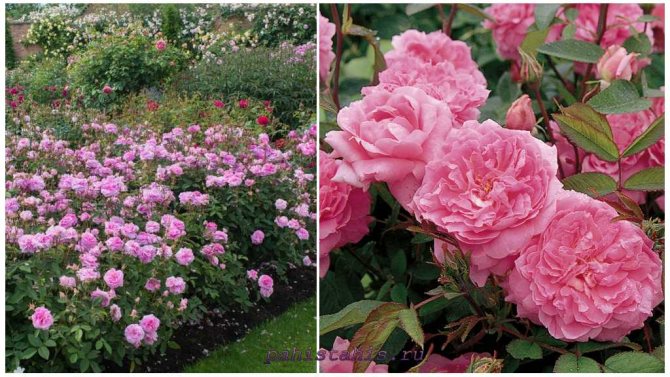

The Mayflower cultivar
The flower was not only beautiful in appearance, but was also capable of re-blooming. Possessed increased resistance to fungal diseases. The pink flowers of this variety are graceful. Possesses a pronounced aroma of rose oil. They bloom early and bloom throughout the summer season. Frost resistant. Thanks to these qualities, the foliage of this variety is not susceptible to disease.
The Mayflower has been awarded a Quality Seal by the British Royal Horticultural Society.
Is it worth pruning roses in the fall and what does it give flowers
Gardeners say that the autumn processing of plants is an effective way to preserve and strengthen the bush, to increase the flowering volume for the next year.
Do not confuse autumn processing with spring processing. The latter is aimed at the formation and refinement of the bush.
Autumn pruning has, rather, a preventive and healing effect. She is:
- provides the stems with access to light;
- allows you to ventilate the crown;
- increases the plant's resistance to frost.
After pruning old shoots, new, stronger and healthier ones appear. The procedure is carried out not only on roses, but also on other flowering plants. Processing is associated with the removal of diseased and weak stems, unripe and already faded buds. Putrefactive processes must not be allowed, which will destroy the entire bush in the winter. Plants become infected with a fungus, after which it is almost impossible to reanimate them.
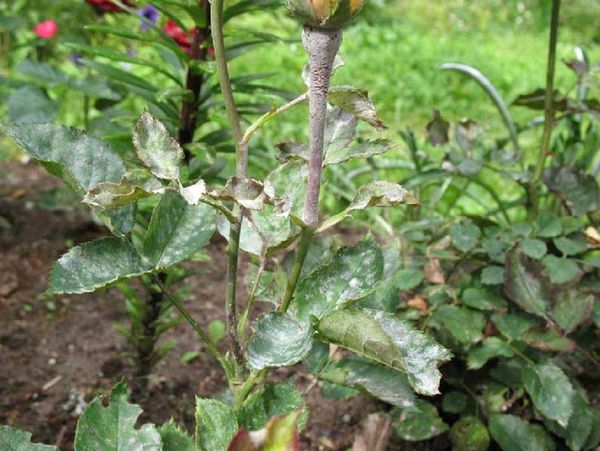

These can be the consequences of improper plant care.
To prevent the development of microbes, all cut rose shoots should not be left under the bush. The land needs to be cleaned of scraps and burned.
Old shoots are considered to be stems that are more than 3 years old. Even though they are in good condition, they need to be removed.
The history of the appearance of flowers
The history of the appearance of flowers goes back to ancient times. In the 50s of the 20th century, David Austin first saw old varieties of roses.He was so inspired by the sight of these plants that he decided to create new flowers that would look like old spray roses. However, David strove to preserve the fragrance and delicate beauty of the buds. The older varieties of roses did not have yellow and orange colors, and Austin wanted to fix that.
By crossing the Bel Aisis and Le Grasse varieties, the breeder received the first flower, whose name was Constance Spray. This rose turned out to be very beautiful, had a peony shape and a delicate aroma. But, much to Austin's regret, this flower bloomed only once, and this was very disappointing for the breeder.
David did not stop, and 23 years after the first attempt, he presented to the public 50 more new varieties, which he bred by crossing different types of English roses. He grafted plants on rose hips, crossed with hybrid tea roses and other flowers. The scent of flowers was very important to Austin, so he paid particular attention to this criterion.
Today David Austin is one of the most successful breeders, selling over 4 million seedlings a year.
Interesting varieties that do not grow in the conditions of the Moscow region
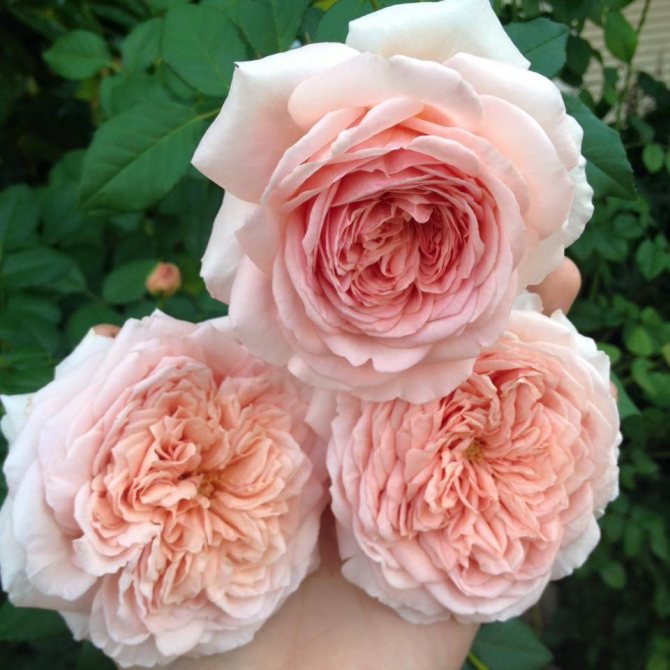

Abraham derby
The enemy, especially masquerading as a delicate beauty with lush flowers, must be known by sight. Even the best varieties of English roses are not always suitable for growing in the middle lane. The fact is that in the climate of the Moscow region, diseases interfere with normal growth and development of crops: powdery mildew and black spot. For example, varieties such as Abraham Derby, Charles Darwin, James Galway, William Morris vulnerable to moisture and rain. If the season is rainy, dense buds do not bloom, the stuck together petals prevent flowering and even begin to rot. Rust begins to appear on the bushes, which can very quickly infect the entire rose garden.
This is not the only minus of English beauties, reviews on varieties of practicing gardeners in the Moscow region. For example, varieties Sharifa Asma, Pat Austin, Saint Cecilia susceptible to high temperatures and do not tolerate scorching heat. If the air temperature rises to + 28-30 ° C, the buds that have blossomed in the morning fall off profusely by the evening. In general, the bush begins to wither, the flowers become smaller and fade very quickly, losing their presentable appearance.
Practicing gardeners also noted the following features of some Ostinka varieties:
- The root system of the Lady Shallot and Crocus Rose varieties should be kept in humate for 6-7 days before planting. This guarantees vigorous growth and abundant flowering of the bushes.
- Golden and Mary Rose, on the contrary, need short-term exposure to growth stimulants, overexposure, on the contrary, inhibits the growth and development of the plant.
- Most varieties of English roses do not tolerate drafts, grow poorly and bloom in lowlands, where the soil is quickly swamped and irregularly ventilated. Ostinks also grow poorly in landscapes where groundwater lies close to the surface.
- It is good when the soil is light, loose and oxygenated. In them, the English rose feels comfortable, is less sick and blooms profusely. If the soil is dense, peat or sand is added to it to provide breathing for the root system.
It is recommended to plant crops in spring or autumn, but before the first frost. When planting in the spring in the fall, you need to dig up and fertilize the soil so that the bush will quickly take root and hurt less in the future.
How to pair Austin rose varieties in gardens
The combination of rose varieties with each other and with other crops is an important aspect of garden planning. What does David Austin say about landscape aesthetics? Here's what he advises for those planning to break the rose garden:
- If you plan to grow roses for landscape design, do not spray and buy many varieties. This is appropriate when a rose garden is needed for breeding and growing crops for export.
- To make the roses look spectacular, each variety is planted in small groups, about three copies at a distance of 0.5-0.75 m from each other.If the bushes have a vertical narrow crown, the distance can be reduced to 0.3 m.
Interesting information! The gardeners of the Moscow region have a different opinion on this matter. Often they recommend planting bushes at a distance of about a meter from each other. As long as the plants are small, the free space is filled with low-growing crops, one or perennials.
- Austin roses of different varieties go well with each other. The soft colors of the buds are in harmony with each other, but do not combine with cultures of variegated bright colors.
- The best neighbors for them will be perennials, compact, without spreading lashes, powerful stems and large buds. The optimal cultures are those that will set off and complement the beauty of the rose, and not compete with it.
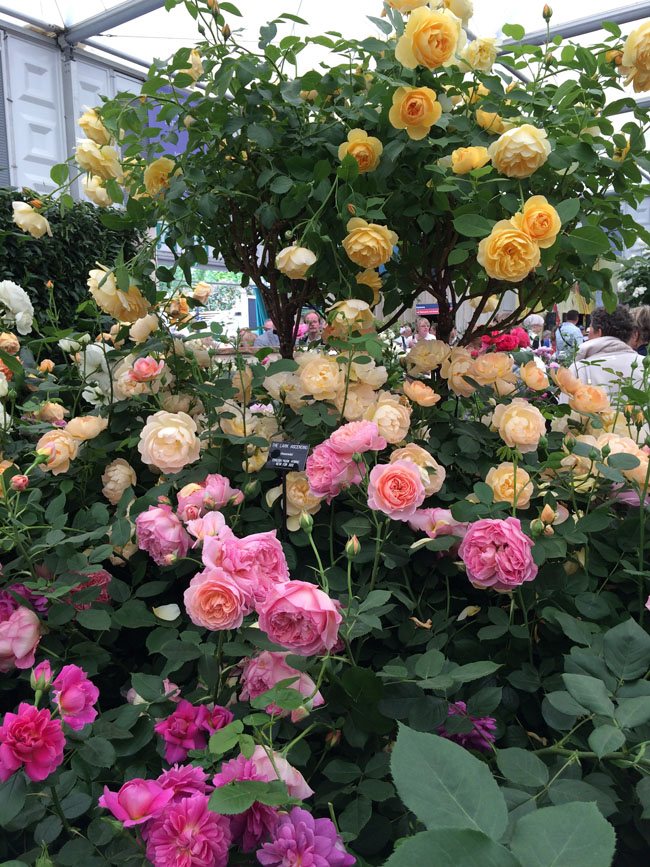

Combination of varieties of roses
Spring pruning is important for the abundant flowering of roses of any variety. It doesn't matter what it will be: a simplified pruning with a simple shortening of the shoots by ½ the height, or a complex one, performed according to all the rules. Regular rejuvenation activates the growth of the bushes and guarantees abundant flowering. Feeding is no less important, especially if the soil is not fertile. Regular intake of nutrients ensures that the crop grows vigorously, blooms profusely, and acquires immunity from disease.
And finally, a little beauty: the roses of D. Austin in our gardens in the photo.
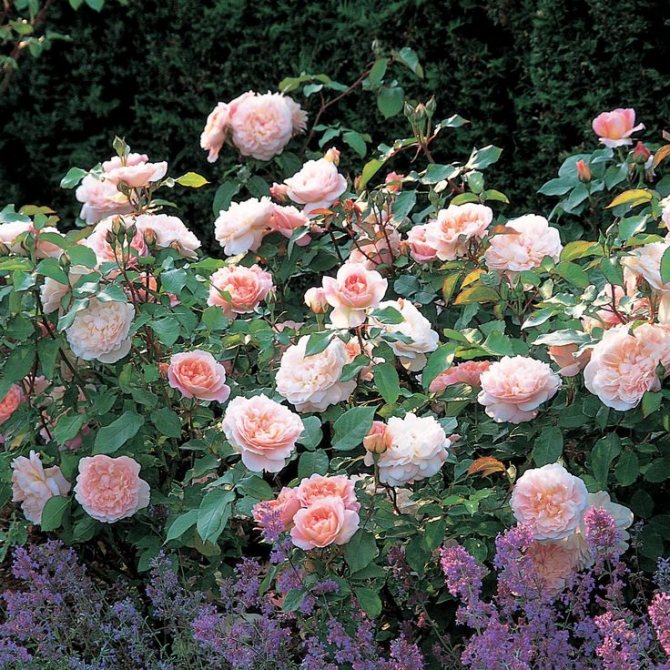

Austin roses in the garden - Mary Magdalene cultivar
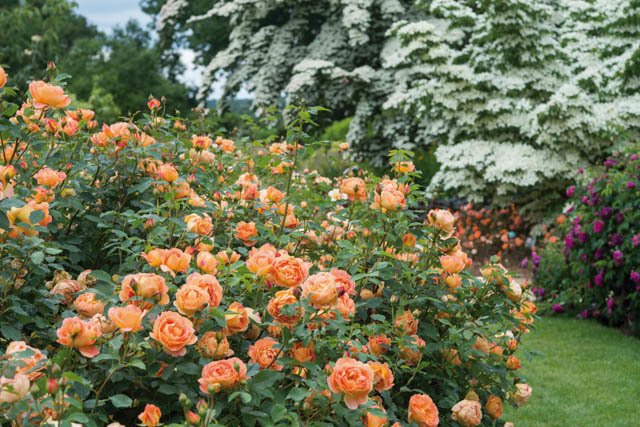

Variety 'Lady of Shalott' in the North Garden
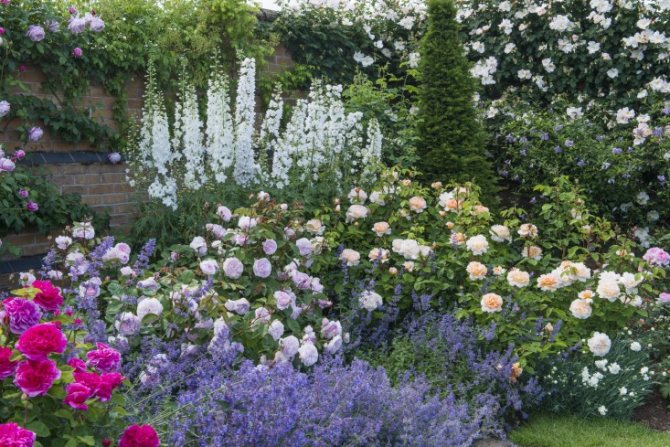

Austin roses mixed with other flowers
Advantages and disadvantages
The main advantages of English roses are:
- the presence of a strong aroma;
- high winter hardiness of the plant in Russian conditions;
- the formation of flowers throughout the stem;
- an unusual flower shape that differs from other types of roses.
But these roses also have disadvantages:
- poor resistance to atmospheric precipitation;
- under the weight of flowers, young shoots often droop;
- many dark colored plants are prone to black spotting.
English park rose: care and reproduction
Caring for English roses generally follows the rules and requirements for caring for ordinary roses. For planting, an air-permeable, humus-rich soil with an acidity of pH 6.5 is selected. Well-rotted compost is introduced into the hole before planting, which is added every spring as mulch. When planting a park rose, the roots of the seedlings should not be dry, so they should be soaked in advance, adding growth stimulants to the water.
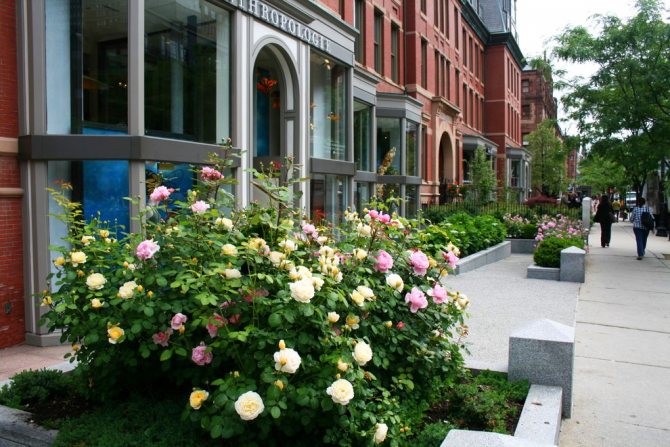

Austin roses as a dominant element in the street landscape. They delight with flowering all summer - most abundant in June, and then the flowering repeats in waves until autumn
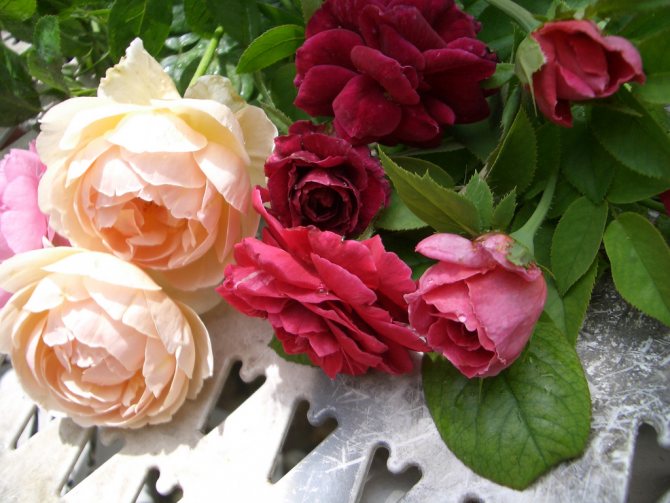

In the photo - three varieties of "Ostinok": Jude the Obscure, Othello and The Prince
Watering
Roses prefer moist, cool soil, so the irrigation regime should ensure constant soil moisture is maintained, especially in hot, dry weather.
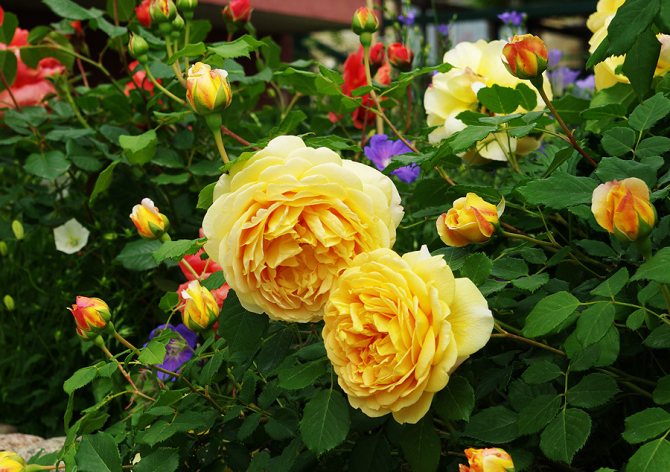

The Golden celebration variety is frost-hardy, but cannot boast of good independent resistance to pests and diseases. The bush is dense and rapidly growing, up to 130 cm high. The aroma of flowers is strong
Advice!
After rains, so that the water does not stagnate on the leaves and buds, which can provoke the appearance of gray mold, the plant can be shaken off a little.
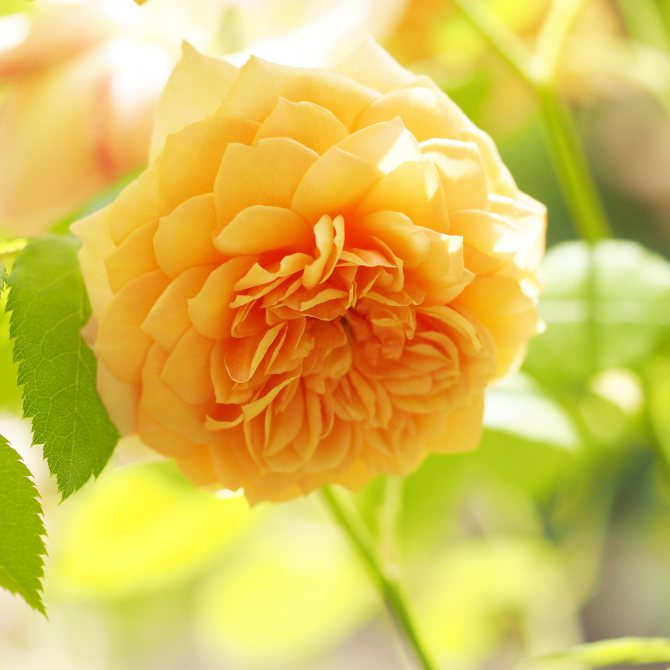

Variety with sunny flowers and noble name "Grace"
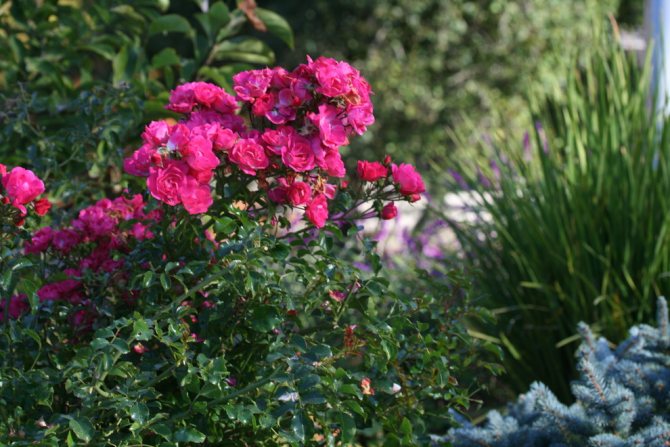

Commercial variety of garden roses "Flower carpet"
Top dressing
Top dressing begins with the beginning of growth, using special fertilizers for roses. In June, during the formation of the green mass, nitrogen fertilizers are applied, with the beginning of the formation of buds - calcium and phosphorus. In this case, it is very important to adhere to the recommended concentration, you can even make it a little less - due to "overfeeding" the English rose may turn yellow and even completely discard the leaves. At the end of summer, feeding is stopped, you can apply a little potash fertilizers to help the wood ripen and become more frost-resistant.
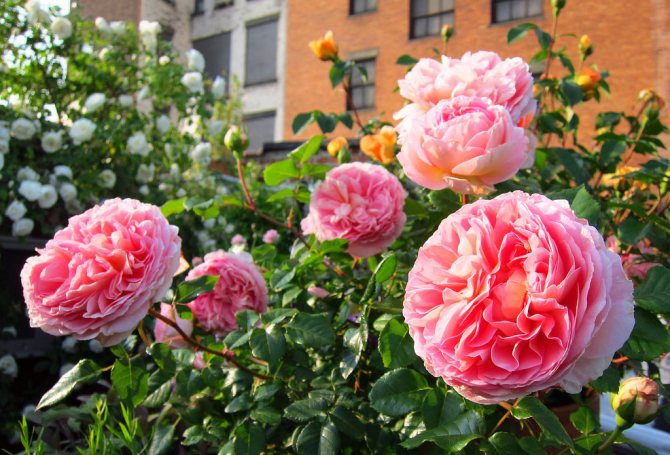

Austin shade-tolerant rose varieties can be planted in areas with direct sunlight 4-5 hours a day
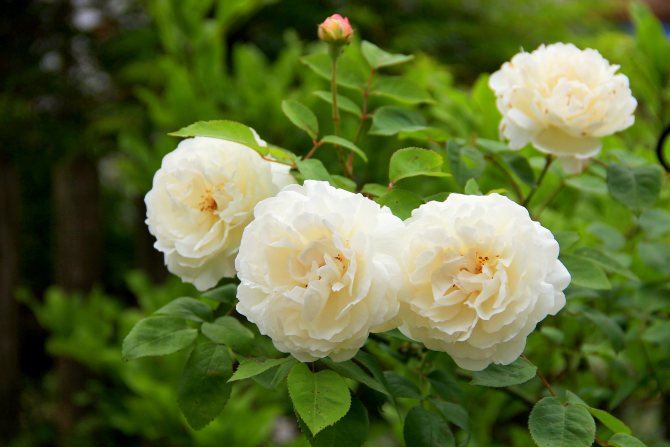

Variety with white flowers: Winchester Cathedral
Graham Thomas
The bush is vigorous, powerful, with strong shoots, in cold climates they can grow up to 1.5 m in length, in the south - up to 3, so this variety can be used as a trellis rose, running it on a support. Arcuate long shoots are strong enough to withstand the weight of numerous (there can be up to 7 flowers in a cluster). The young bud is painted in apricot color, but gradually opening, the petals change their shade to a deep yellow, warm tone, and then fade in the sun, becoming pastel yellow. The flower is large, up to 75 petals, 7 to 10 cm in diameter, cup-shaped, with a bright aroma with pronounced notes of tea. At the same time, at the same time on the bush, due to uneven blooming, flowers with different colors may be present. Yellow flowers look spectacular against the background of dark green, large leaves. Abundant flowering occurs at the beginning of summer, then - for the rest of the season there are “waves” of fairly moderate flowering.
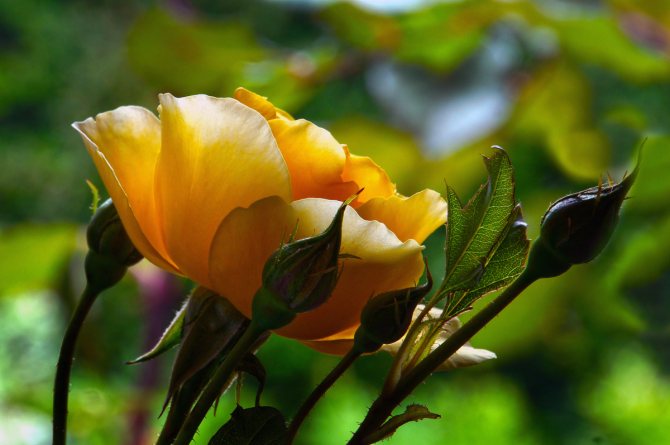

Graham Thomas inflorescences include from 2 to 9 flowers, each with 35 petals. Duration of flowering of one flower - up to 1 week, inflorescence - 8-10 days. Characteristic strong aroma of tea roses. Flowering is continuous. The variety is highly resistant to diseases and frost-resistant.
Advice!
In damp weather, the buds bloom poorly - the upper petals dry out, preventing it from opening. Therefore, by manually removing them, you can help the bud open. For the formation of new buds, wilted flowers must be removed from the bush.


In cold climates, Graham Thomas roses grow only up to 150 cm, while in hot countries they release very long shoots of 250-300 cm, and they can be launched on a support. In general, they are usually referred to as short climbers.
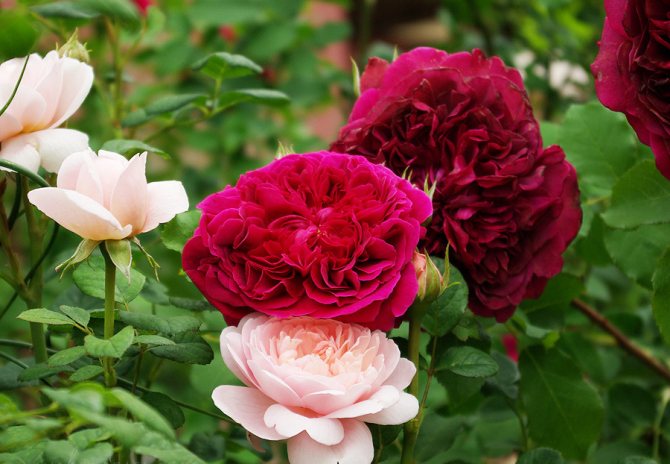

Ostinok varieties William Shakespeare 2000 and Queen of Sweden
Bloom
The flowering period of the Ostins begins in June, the second wave occurs at the end of August.
The peculiarity of care during flowering is to protect the buds from excessive moisture and the scorching sun. After the roses have faded, the buds must be removed.
It happens that a rose does not bloom even in the second year after planting. This can be caused by improper site selection or pruning, overgrowth or inappropriate maintenance. In any case, the cause must be examined more closely. It is advisable to remove small shoots and fertilize the bush with potassium dressings or humate with trace elements.
Grafting roses by David Austin
Roses in David Austin's nurseries for Russia are grafted onto a steppe rose (loose rosehip Rosa Iaxa) with white roots and no growth. The traditional rootstock for roses is rosehip or dog rose (Rosa canina). Each rootstock has its own advantages. Ostinks grow faster on canine. They form a stronger and more powerful bush than on lax.
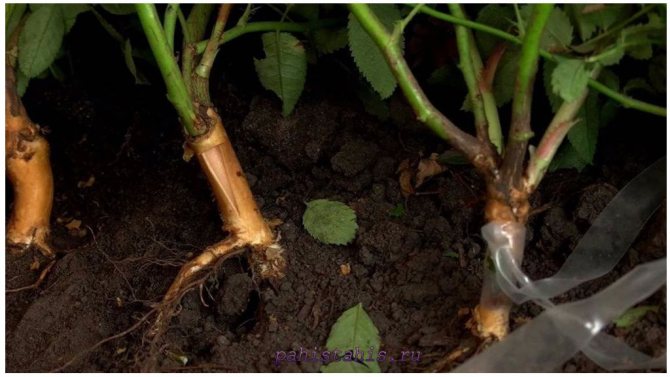

Grafting roses
Such plants are allowed to be transplanted even in adulthood, since the roots of the dog rose are fibrous, and the roots of the steppe are pivotal and go deep enough into the ground, which causes certain difficulties when transplanting the plant.
If you have the desire and skills, then you can plant Austin roses on canina. If a permanent place has been selected for the rose, then you can leave the existing stock. In this case, there will be no problems with the overgrowth.
Important tips and advice when planting
The English rose needs to create suitable conditions under which the plant will develop harmoniously.
An abundance of sun is a rarity in England, so the English park rose prefers to grow in the shade.
Terrain relief
When choosing a planting site for an English rose and planning care, take into account the size to which the bush grows, the type of stem and the composition of the garden:
- climbing roses must be provided with support;
- flower beds - suitable for medium-sized flower beds;
- shrub - to create a hedge;
- ground covers - to create a chic "carpet" of bright fragrant flowers.
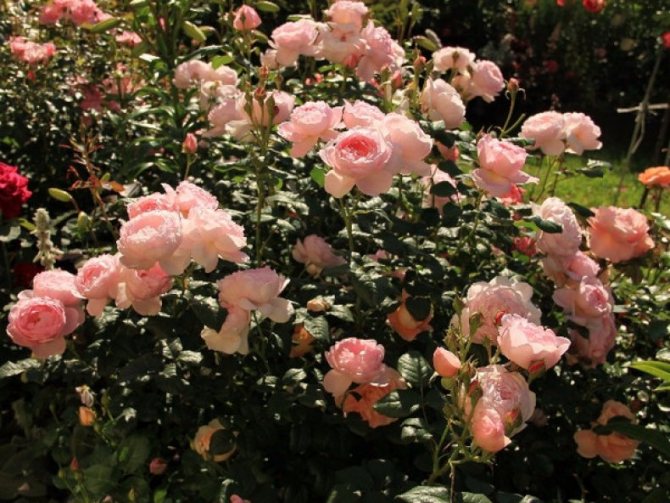

Flowers can grow in poor soil, but subject to loosening, mulching and fertilizing the soil. The soil must be:
- breathable, loose, with good drainage;
- fertilized, ideally rotted manure and bone meal.
The fertilizer layer at the bottom of the hole is at least 2 cm. A layer of non-woven material is preliminarily placed on the bottom of the hole to preserve the fertile layer.
Preparation of seedlings and planting dates
The optimal time for planting seedlings with an open root system is autumn, the last week of September - early October. The seedlings must take root and adapt to the new place before the constant frosts.
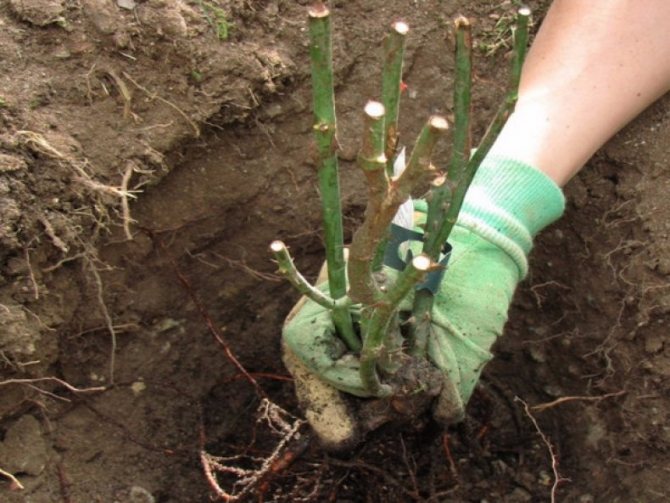

Landing scheme
For seedlings, prepare deep, 50 cm, and wide holes. They need to be positioned so that the grown bushes develop harmoniously and create a beautiful composition. David Austin himself offers a classic planting scheme, 3-5 single-cultivated plants, the recommended distance between which is 0.5 m. At the same time, you should not place the seedlings too close, so as not to interfere with the air circulation around the branches.


